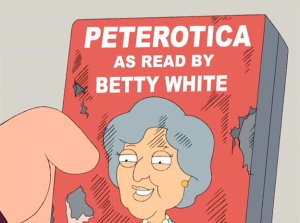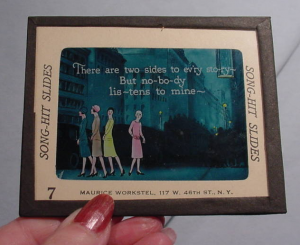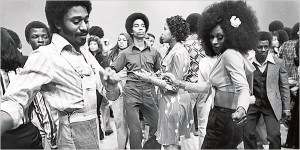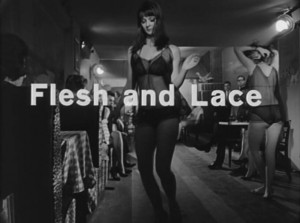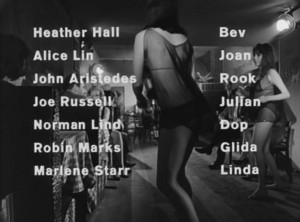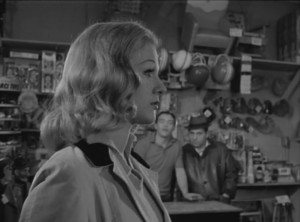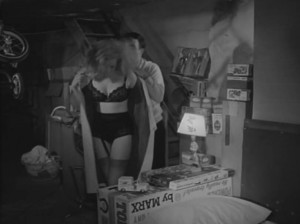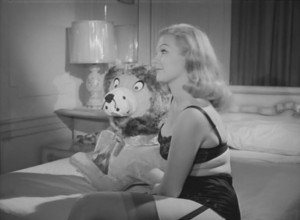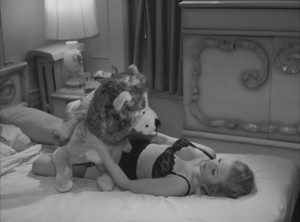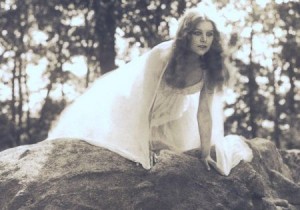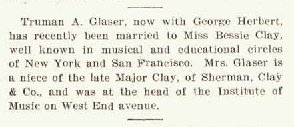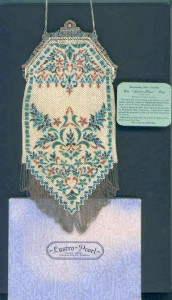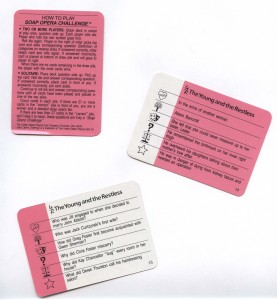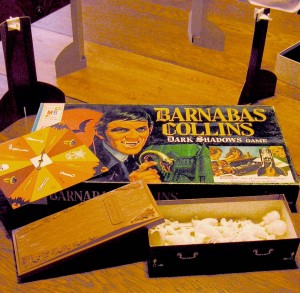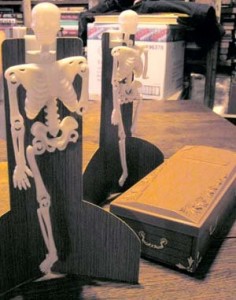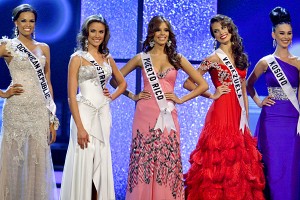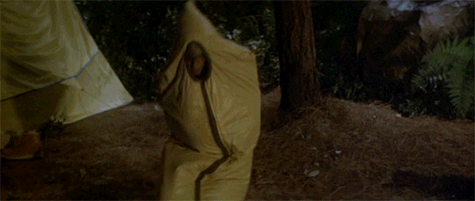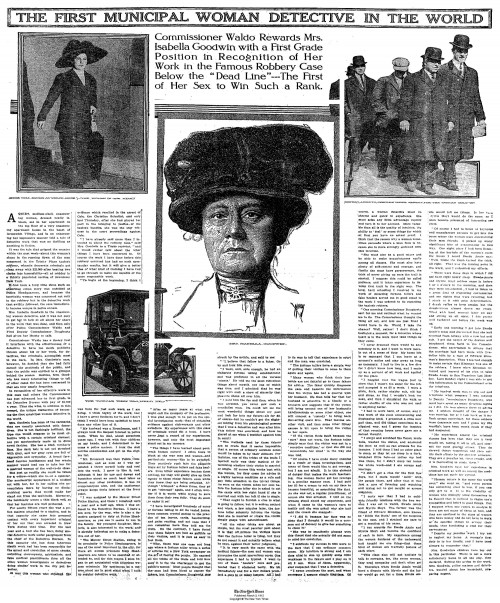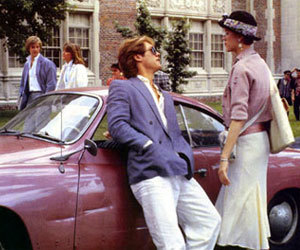I missed seeing Whoopi Goldberg and Joy Behar, The Patriots, walk away from Bill O’Reilly, The Pinhead, on The View; but thanks to the Internet, I can watch it over and over again. Looking forward to watching Joy on the late rerun of her show tonight to hear what she has to say about this:
Category: Screen Test
Film, DVD, TV shows, television commercials, and related moving picture kitsch.
Smoking Anne Bancroft & A Kewpie Doll
This image alone wants to make me watch Gorilla at Large (1954); normally it’s the girl with the dollie and the boy with the cig.
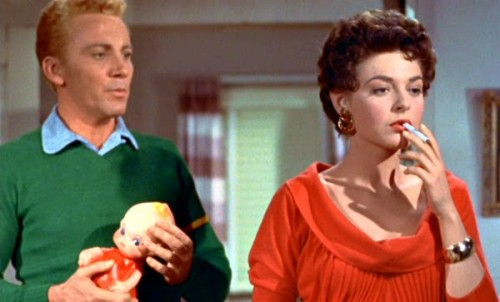
We Love Betty White Because She’s Blue
Betty White is my idol. I’ve been a fan my entire life — even when my beloved grandmother stated her dislike of Ms White (which was weird, because my grandma was sooooo like her!).
I thrill at every chance to watch her, especially when, in 2006, Family Guy included her as the book-on-tape voice of Peter’s erotics novel, or Peterotica:
Welcome to Peterotica on tape! I’m Betty White reading The Hot Chick Who Was Italian, or maybe Some Kind of Spanish by Peter Griffin. Chapter One: “Oh God you should have seen this one hot chick. She was totally Italian. Or maybe some kind of Spanish….
But I digress.
As you all know, Betty White was on Saturday Night Live this weekend. The show drew the biggest ratings since November 2008, pulling in somewhere between 12 million and 13 million viewers, according to preliminary Nielsen estimates, some of whom said the show was too blue — but what the heck did they think Betty White was going to do? She’s been risqué, the queen of delivering double entendres, for decades! And it’s one reason we all love her.
I was especially heartened to see the huge number of former SNL female comedians who returned to perform with Betty. I choose to believe that upon hearing that Betty White was scheduled each & every one of them called and asked to be on the show too. I have no proof of this — and don’t contradict me; I prefer to enjoy such thoughts.
If you missed SNL this past Saturday, you can get yourself on over to NBC.com to watch the entire episode — as well as three sketches which were cut from the show due to time. My favorite of the cut sketches is the “Debbie Downer does a suburban lingerie party.”
The other cut sketches: Joyologist and Bronx Beat.
Magic Lantern Glass Slide: I Want To Sing Along!
This old glass movie slide was probably used in an old movie theatre at intermission or before the show started — when people would sing along with songs together rather than just collectively ignore the ads.
This antique glass slide by Maurice Workstel of New York is from a series called Song-Hit Slides and the lyrics shown are, “There are two sides to every story, But Nobody Listens to mine.”
Fabulous vintage fashions and transportation images; but I want to read more of the song! Anyone know more about the song itself?
Soul Train Lessons
 Hubby and I enjoy the hell out of reruns of Soul Train.
Hubby and I enjoy the hell out of reruns of Soul Train.
Rediscovering lost musical loves and finding new-to-us artists to hunt for, like Johnny ‘Guitar’ Watson, is too awesome. The clothing and dances are feasts for the eyes. Don Cornelius holding the mic a hundred yards away because his deep booming voice doesn’t need a mic, but the show totally believes in the props, is a hoot. Spotting regular dancers and keeping up with yesterday’s lingo… It’s heaven.
But we also play this game when we watch reruns of Soul Train. The Soul Train Game is to guess the year of the episode before the credits roll and reveal the answer.
Amazingly, hubby always wins — even though he was an underage kid when most of these shows aired.
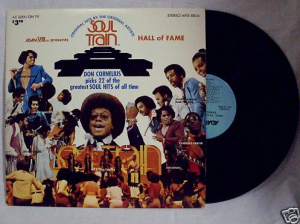 You’d think I’d have the advantage; not only was I buying plenty of records
You’d think I’d have the advantage; not only was I buying plenty of records and tapes, but soon I was out dancing in (and dressing to kill for) the club scene too. But no, hubby, the stay-at-home-young-pup wins.
I’d like to think it’s a matter of me over-thinking my answer (I lived in the Midwest, so how far behind were we in the fashions?). But the simple fact is, he is smarter about this stuff. I’m greatly disadvantaged because I don’t think in terms of years; I view life and history as “chapters” and “episodes,” and am hard-pressed to name dates. His knowledge of technology and historical time lines beats out my real life experience — at least in this case.
(In fact, I always turn to him to help me date any antique or vintage collectible — even clothing — because he’s so damn good at this stuff.)
But I have another point to make, another story to tell, so I’ll move along…
The other day, hubby and I were joking about the Soul Train Game, and Destiny, the 13 year old, asked us what we were talking about. Have you ever tried to explain Soul Train and American Bandstand to a teenager of today?
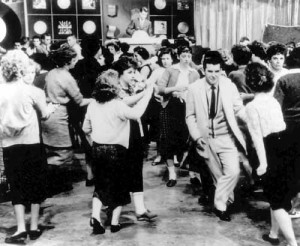 She couldn’t fathom the idea of kids wanting to watch a bunch of kids dance on TV, let alone that those dancing kids had groupies and fan clubs of their own.
She couldn’t fathom the idea of kids wanting to watch a bunch of kids dance on TV, let alone that those dancing kids had groupies and fan clubs of their own.
So how could we move on to the issues of race and lip-syncing — often with a microphone from the future, with a fake short cord that wobbled about. But we did. Because that’s the kind of context geeks hubby and I are.
Honestly, I think Des understood the race issues and the faux Microphone Of The Future better than the concept of turning on the television to watch a bunch of kids dance.
 I’m sure getting over this speedbump of understanding is thwarted by her preference for Goth-kid-attire; she’s not interested in finding out the latest trends in fashion.
I’m sure getting over this speedbump of understanding is thwarted by her preference for Goth-kid-attire; she’s not interested in finding out the latest trends in fashion.
I’m sure the fact that learning dance steps is only relatable in terms of the uncoolness of line-dancing in phy-ed — or today’s shows which emphasis professional dancers, oft paired with celebrities. Destiny’s clearly not thinking she should bust a new move on the dance floor — or that watching teens dance on TV would be the way to learn. You’d Google it, right?
I guess the basic problem here is that these shows didn’t spoon-feed you the dance steps, or break down fashion into sponsored “must haves.” You watched, like a voyeur, identified what you wanted, and figured it out. So to kids today, the concept of watching teens dance on television is like watching a party through a window — only you’re allowed to go, so where’s the thrill?
And so I didn’t even try to get into Solid Gold or the Solid Gold dancers.
Even after she watched Soul Train with us (right after a Ru Paul’s Drag Race episode) it didn’t seem to make sense; she made it through the hour of Ru Paul, but only 20 minutes of Soul Train.
Explaining teenage dance shows to kids today is like explaining the joys of watching fuzzy YouTube clips of a kid & his light saber dancing to Star Wars to the kids of yesteryear.
Shopping For Awesome Toys In Retro Sexploitation Flick
Over at French blog Au carrefour étrange, a review of Joseph W. Sarno’s Flesh and Lace (1965).
Since the site is in French, you may be confused — but it’s apparently exactly how it looks: A film that starts at a strip club and ends up at a toy store, with a woman seduced by a giant stuffed lion.
The images expose glimpses of tantalizing toys and nostalgic games from the 60’s, such as Mastermind, Hands Down, Marx toys, robots, and stuffed animals.
Ah, to be teased by vintage lingerie, nudity, and some incredible retro toys — I must buy this film!
Thanks to Klaudia’s post on the shoe and stocking scenes which sent to me in the right direction to find this review.
The View From Here, Part II
 So, like Stacy (who gave birth during The View), I’ve spent the last few weeks as a Brand Ambassador for The View and thought I should share some of my thoughts on the experience. I’ve blogged about a few of the shows, but I think the most interesting conversations were those I had with friends and family.
So, like Stacy (who gave birth during The View), I’ve spent the last few weeks as a Brand Ambassador for The View and thought I should share some of my thoughts on the experience. I’ve blogged about a few of the shows, but I think the most interesting conversations were those I had with friends and family.
Most of my closest friends are internet friendships — not only because my life as a freelance writer keeps me glued to my monitor, but because these friendships have been formed on mutual interests and issues. As a result, we all seem to have the same likes and dislikes about The View — most especially our feelings regarding the ladies of The View. For example, we love and trust Whoopi, Joy, and Barbara as steadfastly as we pity and mistrust Elisabeth and Sherri. However, I have several family members who feel exactly the opposite.
Perhaps most interesting is that after all these years of watching, after all the Hot Topics discussion, we each continue to remain rather married to these feelings, beliefs and attitudes despite our firm belief that it’s through this discussion, both the ladies on the show and our less public personal conversations, that we not only can but will learn, grow and change.
Yet, I remain as heatedly fixed on Hasselbeck’s righteous fear-based stupidity (yes, “stupidity,” because she cannot claim ignorance) applied as fear mongering to limit and control others as I’ve always been.
Heck, I still get hot about Hasselbeck‘s confusion between love and sex, her insistence that fairy tales are sex education, and her preaching that the only way we can be saved from the realities of the world we all live in is to stick our heads in the sand — including forcing everyone to join her under said sand and limiting the rights of others even further; she discriminates and insists we all do it with her! That was years ago and my ire won’t die. Not until such stupidity is gone and done.
But neither does the support of Hasselbeck’s position.
So does The View really do what we all believe it will?
Perhaps not — if the only way one measures the importance of such talks is a change in position. But if you consider the benefit of talking in other ways…
Most of the time we take the high road and agree to disagree, taking it to the extreme of avoiding such conversations out of respect. But the cost of doing so is that we avoid the issues.
With The View, we have a frame for the conversation, a table to sit at, and, perhaps best of all, a time frame for discussion. If we listen and talk with each other and then move along to the next thing — be it an issue we agree on, a celebrity interview, or some shopping thing — we have set limits and prove that we can discuss, agree to disagree, and still connect on other issues. Our conversations can be challenging but our relationships need not be challenged.
This, however, is thwarted by The View‘s time slot.
Too many people work days when The View airs. Watching “together” even though miles apart isn’t the only problem; TiVo space and hours in the day not being infinite, intentions of watching later may pave the road to hell. Even watching episodes online is problematic… Even if these family members of mine use the internet (and many of them don’t use it beyond email & photo sharing), it’s just not the same viewing experience.
Maybe ABC should consider giving The View an additional evening showing. Who wouldn’t rather watch it than another same-old Jay Leno dealio?
*****
As a Brand Ambassador for The View, I am a participant in a Mom Central campaign for ABC Daytime and will receive a tote bag or other The View branded items to facilitate my review; as you can tell from my long-winded posts about The View, the tote or whatever I may get is not my priority, but I mention it to be ethical.
Too Many Babies, Not Enough Babies, WTF
The ladies of The View were not immune to the irony of having a show about infertility one day after the show with Nadya Suleman aka the Octomom. In their Hot Topics discussion (always my favorite part of the show), Whoopi noted it and there was brief discussion on why Suleman arouses so much heated debate.
http://www.youtube.com/watch?v=lKBVeL5VJi8
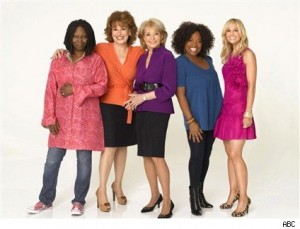 At first I was surprised when Hasselbeck defended Suleman — I expected her to be a hard-line republican on the welfare business at the expense of fetal life, even though that fetal life was a medical “opt in” not a manual one — and by a single mother yet. And I was more than a bit surprised by Whoopi as well. I wasn’t surprised at her talk of responsibility in having so many kid so much as what was missing from the conversation.
At first I was surprised when Hasselbeck defended Suleman — I expected her to be a hard-line republican on the welfare business at the expense of fetal life, even though that fetal life was a medical “opt in” not a manual one — and by a single mother yet. And I was more than a bit surprised by Whoopi as well. I wasn’t surprised at her talk of responsibility in having so many kid so much as what was missing from the conversation.
See, what bothers me the most about all the Octomom haters is the lack of compassion and tolerance. Not just for the buckets of crazy that motivate having so many children, but for outrage expressed at her while folks like the Duggars (of 101 Christian Pups & Counting) continue to skate — even past Jon & Kate Plus 8 before the marital drama. I vented about all this before, but here it is again:
Before watching the Dateline interview of Nadya Suleman, my only interest in this story was the passing thought of, “Will this family replace Jon & Kate Plus 8??” I honestly had no idea of the squawking & hostility towards this mother of six who just gave birth to octuplets. In fact, I was surprised to hear of it — and that’s what drew me towards the show.
(Personally, I’d like to lay a large part of this concerned indignation from our nation on the bitterly infertile; but even the fertile seem to be pissed off. So it’s larger than that… Hit a larger American nerve.)
What I saw was an articulate young woman who managed to keep her own anger at bay, who seemed understanding and forgiving of people who do not accept her decision, and was composed yet passionate as she tactfully mentioned her beliefs about the sanctity of life. But it was her earliest statements, regarding other large families, which seemed to lie at the root of all of the hullabaloo.
When two parent families give birth to &/or adopt other children, people seem to respect them. We’re fascinated, yes; we’ve got television shows, both series and ‘specials’, dedicated to such large & extraordinary families. But we treat them with respect in those shows.
However, few seem to respect this woman. As they said on Chelsea Lately, single, unemployed moms who aren’t entrenched in their community church aren’t cute. Funny? Sure. But too true; and that’s what’s not funny. As were the comments Chelsea Handler made tonight (Tuesday, February 10th) about a new mom having a French tip manicure — seeing those nails near such paper-fragile premature baby skin made me whine and wince. And yes, there are some questions about where the money for manicures and whatever is going on with mom’s new lips… But would these statements be made with such heat about other new moms?
Would we trust the judgment of children? When her older children are questioned on Dateline, they mention ‘squishy’ (aka crowded living space) and crying babies. Those may be true things, and even un-coached or non-parroted statements they heard from adults; but are children known for their unselfishness? Not all children welcome additional siblings period. Does that mean parents or persons considering becoming parents take the advice or sentiments of their children to heart and not increase their family’s size because their children complained?
I’m no pro-lifer, but as the mother of special needs children are the plethora of haters (& Dateline) actually saying that it is irresponsible for a family to increase in size because they have special needs children? And sure, special needs kids come with extra bills — but I don’t see anyone worried about me and my family struggling to care for my special needs kids… Where’s the concern for us?
I’m not saying I think Ms. Suleman has all answers or answers that I’d like to hear when it comes to caring for her children; but then, see, that’s the point: This is not my family, these are not my questions to answer, I am not the judge. I’m not a Christian, but I think that’s supposed to be the Christian way; to leave the judging to God.
This is not to say that I, or anyone, shouldn’t care about the welfare of this family, these 14 children — but then most of the people worried are freaking out about the word ‘welfare’ so maybe I shouldn’t use that word…
We currently have no test or licensing practices for parenthood; even adoption has few rules if one has enough money. And don’t let money fool you either; money doesn’t free any family from neglect and abuse — which is what most everyone is talking about in defense of their questioning this woman’s right to a large family.
But it seems to me, too much emphasis is this woman’s single status. It seems to be the bottom line of all the upset reminding me of the old fuss about Murhpy Brown having a baby; a big moral debate about choosing to be a single mom.
Have a two-parent family who keeps popping out children because they don’t believe in birth control, and few take them to task for their lack of common sense, even when they live on the government dole, or in a house that is ‘squishy’. Extra points if they evoke God a lot. And when they have specific religious or church affiliations, no one dares to really berate them because they have religious protections & a coven of church brothers and sisters.
You want examples? Fine. Those annoying Duggars (of 17 and Counting) take their kids to a “wild life refuge” and allow/encourage their kids to feed animals pasty white bread from their mouths, run & chase animals despite the “do not chase the animals” signs — and when asked, bozo dad Duggar says he wasn’t worried about his kids. Apparently God will protect his kids from his own stupidity. Plus they do all sorts of impractical and stunting things to their kids in the name of religion — so we aren’t supposed to judge. Even my beloved Kate of Jon & Kate Plus 8 totes & promotes her faith.
Most egregiously of all, the Murphy family, headed by John and Jeanette Murphy, who, already the parents of four, opened up their home — aka privately adopted — 23 children with Down Syndrome and were the subject of Our 27 Kids. If you want to talk about what’s fair to the children you already have, where’s the outrage that they placed upon their young biological children (two who existed before they began adopting, and two born after) the burdens of special needs siblings? It’s not just the daily grind either — it’s for the lifetime of those children they’ve adopted. As a mom who has had to deal with the safety of one child’s future — aka legal guardianship — in light of other children’s needs, I can’t imagine saddling children with 23 such responsibilities.
But we don’t talk about these issues. Or their economic dole. The Murphy’s admit they too take food stamps, like Ms. Suleman; Jon & Kate likely don’t need them due to their TV deal, their church, etc.; and I bet the Duggars took food stamps & more — at least before the TV deal — and their children, ill-prepared for the real world, are destined to return to such public assistance in the future. But we don’t talk about them because these are two parent families who evoke the name of God & their idea of His vision of morality when speaking of their large families. In the case of the Gosselins & the Murphys, their marital status is a tacit approval of God for most of the gossip-mongering public so ready to judge Suleman.
I guess Suleman should get all kooky with an old time religion and marry a man; preferably the man who biologically fathered her kids — the man her mother claims offered to married her. Then would everyone just shut up about her — or at least just talk about the blessings and realities of raising so many tiny babies? Judging isn’t going to diaper and feed those eight babies. Or her six other children. Nor is is going to help a new mom with her stress. It’s just empty finger pointing.
Well, it’s not completely empty finger pointing… Every finger pointed at Suleman has three more fingers pointed back the the finger pointer. And maybe those people should start there, looking at what makes them so judgmental.
Whew. I’m glad to have that all off my chest. Again.
But back to The View.
(Not that this whole discussion wasn’t about The View; it was. Like I said, Hot Topics is my favorite part of the show, primarily because it’s just like how women talk. But it’s time to leave the Octomom alone and move along.)
 Yesterday’s episode was a “special episode” about infertility. While I am not without my sympathies for this issue (something my sister and most of her friends have had to deal with), I am waiting for today– Friday’s — Hot Topic fallout regarding the segment with Bill and Giuliana Rancic. (I know it will be there — especially as Joy mentioned it on her HLN show this evening.)
Yesterday’s episode was a “special episode” about infertility. While I am not without my sympathies for this issue (something my sister and most of her friends have had to deal with), I am waiting for today– Friday’s — Hot Topic fallout regarding the segment with Bill and Giuliana Rancic. (I know it will be there — especially as Joy mentioned it on her HLN show this evening.)
The short version, for those too lazy to click the above link and watch, it that Giuliana stated that her doctor advised her to gain 5 to 10 pounds to assist conception — and Giuliana resisted.
Now I get that her career is to be a thin woman-child waif on the red carpet etc., and that such a gig requires her to be thin, plus lose an extra 10 for the camera. But her reluctance seemed to have exposed a resentment that she should have to do such a thing in order to have a baby — as opposed to the more sane response that her career ideal weight would be so low that it would interfere with her basic biology.
Giuliana and Bill are both to be admired for sharing their intimate problems for, as they state, the ability to remove the taboo from fertility issues. So I don’t want to sound too harsh or kick folks when they are already down. But…
Giuliana’s statements regarding her earlier career-formed impressions that as a 20-something watching 40-somethings having babies had led her astray, given her the wrong impression about how much time she and her biological clock really had. So perhaps it’s time for Giuliana to see that she too is sending unfortunate messages to women.
By resisting those baby-needed 10 pounds, by emotionally fearing the horrid industry standard of “fat” rather than be horrified by just what those standards do to her and other women who aim to be so slim, she is not only receiving the wrong message, but sending it too.
She would do herself and those who view and idolize her better by accepting the literal baby fat and making a stink about the fictitious and unhealthy standards.
*****
As a Brand Ambassador for The View, I am a participant in a Mom Central campaign for ABC Daytime and will receive a tote bag or other The View branded items to facilitate my review; as you can tell from my long-winded posts about The View, the tote or whatever I may get is not my priority, but I mention it to be ethical.
The View From Here
 Last week I became an official View Brand Ambassador, part of the Mom Central campaign for ABC Daytime. This means you’ll be hearing more from me on The View and while I will receive a tote bag or other The View branded items for &/or to facilitate my commentary &/or reviews, I’m really excited to have the opportunity to participate in the discussion about and promotion of one of my favorite shows — yup, one of my favorite shoes, not just a daytime favorite. It doesn’t hurt that we’re supposed to get some face or ear time with show producers either.
Last week I became an official View Brand Ambassador, part of the Mom Central campaign for ABC Daytime. This means you’ll be hearing more from me on The View and while I will receive a tote bag or other The View branded items for &/or to facilitate my commentary &/or reviews, I’m really excited to have the opportunity to participate in the discussion about and promotion of one of my favorite shows — yup, one of my favorite shoes, not just a daytime favorite. It doesn’t hurt that we’re supposed to get some face or ear time with show producers either.
In short, being an ambassador for the show means I now have a legitimate reason to watch shows uninterrupted and a larger motivation to talk about them too.
So consider this post a disclaimer — and warning of things to come, both here and at my other blog, Motherhood Metamorphosis. (Heck, it might even show up at other places, depending upon the topic!)
If you’re a fan of The View, right now Mom Central has an exciting contest: The View Sweepstakes. The prize for one lucky winner? A trip to New York City to watch a taping of The View! The sweepstakes is open until February 28th and I encourage you to enter — but I hope I win!
PS If you join Mom Central, befriend me here!
Of Brown Marie, Yellow Marie, And Pickaninny (Or, Of Racism In The Toy Wife)
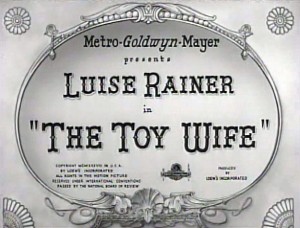 I don’t think I can let Black History Month go by without mentioning 1938’s The Toy Wife.
I don’t think I can let Black History Month go by without mentioning 1938’s The Toy Wife.
Primarily the movie is the story of Frou Frou (played by Luise Rainer), a woman found to be so guilty of a frivolous nature, so childlike in her approach to life, that she must suffer the wrath of The Motion Picture Production Code (aka the Hays Code or Hollywood Code). But I think any woman or thinking man who watched the film will see that others are not only guilty of perpetuating her frivolous nature, but of exploiting it as well — especially those who claim to love her.
In many ways, Frou Frou, the character, reminds me much of Norma Jean Baker, or at least the creation of Marilyn Monroe… A woman literally and figuratively corseted by the studios to be “feminine charms personified,” who was then resented and mistreated by the very persons who had shaped her. (Any feminists reading here likely can feel the echoes of such things in their own lives.)
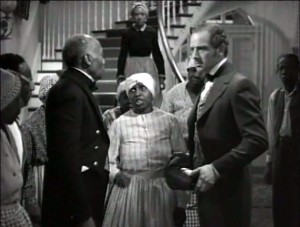 Jaynie’s done a great job in her review of the movie, so I’ll leave it at that and get onto the other thing to note about this film: the racial issues.
Jaynie’s done a great job in her review of the movie, so I’ll leave it at that and get onto the other thing to note about this film: the racial issues.
Heck, slavery and racism are so prominent in this film that it’s used as proof of Frou Frou’s poor frivolous and immature state.
Her inability to manage her household and slaves leaves her poor husband dealing with bickering slaves; leaving us to conclude that Frou Frou is so childish, she cannot even manage the childish Negros.
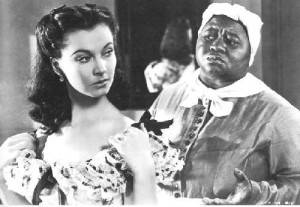 Sure, The Toy Wife is a period piece set during the Civil War on a plantation — with all that implies. But unlike Gone With The Wind, The Toy Wife shocks with insights into the treatment of slaves.
Sure, The Toy Wife is a period piece set during the Civil War on a plantation — with all that implies. But unlike Gone With The Wind, The Toy Wife shocks with insights into the treatment of slaves.
We see the traditionally accepted sanitized version of supposed mutual devotion and affection between master and slaves, both on individual bases and and in groups — such as when the mistress of the household stand on the magnificent steps of her plantation mansion and leads the slaves in prayer.
We see Frou Frou slap her slave, something which tells as much about the immediate situation straining their close relationship (you know how women are so willing to slap one another’s face when we get peeved *snort*) as it depicts slave relations.
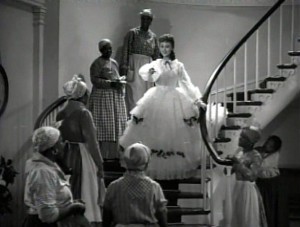 But we also see and hear family slaves threatened with whippings and being sold, the rather nonchalant pronouncement of such things by white folks punctuates their manipulation and mastery of human beings — exposing the very same frivolous, spoiled, childlike assumptive behavior that Frou Frou is charged with.
But we also see and hear family slaves threatened with whippings and being sold, the rather nonchalant pronouncement of such things by white folks punctuates their manipulation and mastery of human beings — exposing the very same frivolous, spoiled, childlike assumptive behavior that Frou Frou is charged with.
But perhaps most shocking is the story of Frou Frou’s devoted personal slave. Played by Theresa Harris (more here), this slave hasn’t any name — they just call her “Pic” (or “Pick”) short for pickaninny.
We discover this supposedly amusing fact when Frou Frou returns home after years away, being schooled abroad. One by one the female slaves identify themselves — including both Maries who individualize themselves as “Brown Marie” and “Yellow Marie.” You will see and hear it in this YouTube clip (at roughly 37 seconds) but Pic’s story, which should immediately follow once the young woman is spotted beneath the stairs, has been (curiously and infuriatingly) omitted.
http://www.youtube.com/watch?v=5DUso6KmQlQ
So while The Toy Wife offers a sad story of womanhood, it also offers an historical slice of southern pie that’s hard to swallow.
But you should watch it. It’s a wonderful film, capturing so many moments of truth… Even if a lot of them are ugly and painful.
Oh, Those Von Dewitz Characters
Because I become obsessed with research, especially when so little is readily available…
In doing some additional research for a piece on silent film star Valda Valkyrien…
I found juicy tidbits on her first husband, Baron Hrolf von Dewitz.
From The New York Times on September 7, 1919:
Special to The New York Times
GREENWHICH, Conn., Sept. 6.– A man calling himself Baron Hrolf J. O. E. Dewitz of New York, a moving picture director, and a girl who said she was A. M. Thaisn de Malmey, a moving picture actress, and daughter of Joseph W. de Malmey and Catherine Thomas de Malmey, were married today by Justice Albert S. Mead in his office. They came up by train from New York, and the bride changed from a traveling dress into a gorgeous pink creation for the ceremony and back again afterward into her traveling costume. Dewitz gave his age as 40, and said he was born in Denmark, and Miss de Melmey gave hers as 21, and said she was born in Spain and was a cousin of the late Empress Elizabeth of Austria. They said they had never been married before. They left for New York, saying they would leave New York Sunday morning for the Pacific Coast.The so-called “Baron” Dewitz, in spire of his statements to the Greenwich Justice, has been married before, not only once, but several times, and his erstwhile wives are on record as divorcing him. Records show that on May 17, 1908, he was married to Nina Pastorelli, a toe dancer with “The Dancing Daisies.” On April 4, 1911 he married Mrs. Katheryn de Montford, an actress, who obtained a divorce from him on Jan. 18, 1912. His third venture was with Miss Freed, whose stage name was Mlle. Valkyrien, another dancer, who as Mrs. Adele Freed von Dewitz also got a divorce, the interloculory decree having been signed on Feb. 13, 1919, by Justice Albert F. Seeger at White Plains. She was then in the movies, and the decree gave her the two-year-old son of the pair.
At the time he married Miss Freed, otherwise Mlle. Valkyrien, the “Baron” sent out cards announcing that their residence would be at the Plaza after Sept. 1, 1914, but at the time the cards were issued he and his bride were living at 560 West End Avenue with a Miss Bessie M. Clay.
So far, I’ve not found anything substantive about the earlier Baronesses von Dewitz (and you know I’ll keep looking — The Dancing Daisies?! Oh. My. Gawd.).
 But I did then find a lengthy wedding notice, also in The New York Times, dated June 23, 1914. (I’m so going to interject along the way for this one.)
But I did then find a lengthy wedding notice, also in The New York Times, dated June 23, 1914. (I’m so going to interject along the way for this one.)
Cards bearing the imprint of a jewelry house and the baronial crest of a noble Danish family were sent through the mails yesterday to well-known New Yorkers, saying that:
Lo Lieutenant Baron Hrolf von Dewitz,
et Mademoiselle
Valkyrien Freed de Copenhaque
ont l’honneur de vous
announcer leur mariage en date du
quatorze Mai, a L’eglise
Evangelicale-Lutherienne de Saint Mathieu
a Jersey City
Don’t you just love “Jersey” tacked on the end of all that French — and when, for that matter, did Valkyrien become French?
A second card states, also in French, that the Baron and Baroness would be at home at the Hotel Plaza after Sept. 1.
Baron von Dewitz, whose marriage on May 14 in Jersey City is thus announced, is the same Baron who on April 4, 1911, married Mrs. Kathryn de Montford, an actress, at Stamford, Conn., and who, several years previously was reported married to Nina Pastorelli, a toe dancer. Although the alleged marriage with Miss Pastorelli was extensively published in the newspapers, it was shown later that the wedding did not take place.
The matter of being shown that the marriage to Miss Pastorelli did not take place is A) not as reported later, and #2, not really shown at all.
In his most recent matrimonial venture Baron Dewitz again went to the stage for a wife, for Mlle. Valkyrien Freed is a dancer and a member of the ballet of the Royal Theatre in Copenhagen. Furthermore she is about to embark upon a professional career in this country despite her title, and at a dinner tonight at the home of Miss Jeannette L. Gilder, the writer, her stage future is to be talked over by her husband, Miss Gilder, who, through taking the management of another dancer has become an enthusiastic impresario, and the Baroness herself.
Please note the Baron’s involvement in his wife’s career; there is more flavor to savor later.
Although the wedding announcement cards say that the Baron and Baroness will be at home at the Plaza after Sept. 1, they are at present living at the home of Miss Bessie M. Clay, at 560 West End Avenue. It was explained last night by Baron Dewitz that this was because he and his bride wished to live in seclusion for a while, and at the same time it gave the Baroness an opportunity to practice her toe dancing.
The Miss Bessie M. Clay mentioned is likely the then President of The New York Institute of Music, located on West End Ave.; more on her, and why they would live with her, is here.
The marriage of Baron Dewitz and the toe dancer, who is not yet 19 years of age and who is a young woman of remarkable beauty, ends all the chances the Baron had of coming into a great estate and another title, he said last night. In fact, he is likey to be cut off by his relatives altogether for not returning to Copenhagen and marrying into a royal family.
“This wedding with Miss Freed,” said the Baron last night, “was a real romance. Two years ago when I was at home I met her and we fell in love. I returned to this country and we wrote each other frequently, but my family, and hers, too, put so many obstacles in our path that we gradually stopped writing. Last month we decided to marry after all, and so she came to this country. I met her at the boar and took her to the home of a married sister in Jersey, and a week later we were quietly married.
Put a pin in that “met two years ago” part — there will be some math.
“We are going to Newport in a short while, and she may give some exhibition dances there. I have been approached with offers to to upon the stage, but I am told that in this country a man who goes on the stage is not likely to be taken seriously in business affairs afterward. In my country I could go on the stage as a lark and nothing would be thought of it.
Remember when I asked you to note the Baron’s involvement with his latest wife’s performance career? Well, it sure seems to me that the Baron von Dewitz desperately wants a stage career himself. He’s willing to give up his title and wealth for it. And remember that first (though more recent) article wherein he calls himself “a moving picture director” — I guess that line’s a winner.
“The report that I have been married several times is all a mistake. I knew Miss Pastorelli when I was here some years ago and was seen about with her frequently. Some months after I had left this country I was surprised to get some old newspaper clippings saying that Miss Pastorelli and I were married. It was so long after the time that the stories had been published that I did nothing at all about it. I was divorced from Mrs. de Montford about a year and a half ago.”
But remember, the later clipping states that “records show” his marriage to Pastorelli on May 17, 1908. “Records,” not “reports.”
And remember, you have a pin in the number two, right? Do the math with his statement that he “was divorced from Mrs. de Montford about a year and a half ago.” Erm.
Baron Dewitz, who writes for the magazines, was a Danish naval officer who was one of the first to take up aeroplanes as war machines, and for some time was interested in perfecting air warship which he wished to sell to European Governments. He said last night that the cost of the enterprise was so heavy that he finally dropped it.
Baron Dewitz apparently did write, including a book titled War’s New Weapons.
At least that much is true.
*About Miss Bessie M. Clay and The New York Institute of Music: A bit from The New York Times, October 22, 1905:
An interesting feature of this college is what is known as the “Home Department.” As more and more girls have been coming from places far from New York to study music, there has been a growing demand for their proper accommodation in the city. Accordingly it is now possible to obtain not only musical instruction at the institute, but rooms, board, and chaperonage can be secured. But the care of the visitor does not stop here. Informal teas and receptions will be arranged to which persons prominent in the musical and artistic world will be invited. There are classes in dancing and fencing, and there is also a bowling alley and gymnasium. In other words, a student from the West can secure here many of the advantages and pleasures she would find at a college like Wellesley or Vassar.
I believe this 1906 issue of Music Trade Review is also on Miss Bessie Clay (said to be the niece of Major Clay of Sherman, Clay & Co.) and her marriage to Truman A. Glaser.
However likely this seems to be the same Bessie Clay, I cannot account for the continued reference to her as “Miss Bessie” past 1906.
And that brings us to the end of today’s (last night’s) obsession. Until I find out more — or you add to the story with what you know.
Once again, I’d like to declare my deep abiding love of The New York Times for making their archives available.
We Had Joy, We Had Fun, We had Seasons In The Sun…
I’ve been listening a lot to the cable music stations — most recently to the 70’s station. Tonight, Seasons in the Sun by Terry Jacks came on and I found myself singing along as I had in my childhood:
We had joy, we had fun, we had seasons in the sun
‘Til the cops came along and shot us in our buns.
At this point hubby (10 years my junior, remember, and so perhaps not even born at the time I was singing along to the AM radio), turns around and calls me an affectionate slur for a mental handicap.
“Come on,” I laugh, “I was like 10 years old when this song came out.”
And I continue to sing along with the song — growing happier and louder with each opportunity to sing my childhood recollections of the verse. I was seriously clapping with glee by the end of the song. Perverse? Maybe. But it was thrilling to relive my 10 year actions and enthusiasm.
Blaming my age might seem like a weak defense, but honestly, little kid weirdness can often be attributed to very real — and very grown-up — things.
Streaking was a big thing then (at least pop culture reference wise; I never knew anyone then who had done so) and as kids, uncomfortable with the notion of naked adults, we made jokes about it. Continually.
And the song, Seasons In The Sun, was terribly depressing; it reeked of death. Another thing kids would be terribly uncomfortable with.
So we dealt with our anxieties via the mutilation (further mutilation?) of the song.
Come to think of it, so many 70’s songs were about death…
There was Wildfire and Brandy, of course (the latter of which may not have explicitly about death, but certainly there was loss). Helen Reddy’s Angie Baby used to scare the crap out of me (that swirling noise made me dizzy and is somehow mythologically tied to my experience with the floor dropping in Disney’s Haunted Mansion) — second only to Eleanor Rigby, which, with the popularity of Wings, was played far too often as far as I was concerned. (Wearing a face that she keeps in a jar by the door?! I’m old enough to understand the lyrics better now, but that only creeps me out more.)
However, in terms of raw exploitation and manipulation of emotion, there were even worse offenders.
 Like Rocky (“Rocky I’ve never had a baby before, don’t know if I can do it…”) by Austin Roberts. In my mind, Rocky was from the made for TV movie, Sunshine, which was based on the real life story of Jacquelyn Marie “Lyn” Helton, a young woman who while dying journaled for her young daughter so that she’d remember her (unbearably more than ironic if this post is to be believed).
Like Rocky (“Rocky I’ve never had a baby before, don’t know if I can do it…”) by Austin Roberts. In my mind, Rocky was from the made for TV movie, Sunshine, which was based on the real life story of Jacquelyn Marie “Lyn” Helton, a young woman who while dying journaled for her young daughter so that she’d remember her (unbearably more than ironic if this post is to be believed).
I recently discovered that Rocky was not from that film when we found the record at a thrift shoppe (and yes, I snatched it up). I don’t think I ever saw the Sunshine movie, or the television series which followed…
But maybe I did. In my mind, it was all twisted up with my Sunshine Family dolls. Dolls who suffered greatly, despite their cheerful happy hippy faces. One parent often died… Of course, it could have been worse for the children after I read Flowers In The Attic (the baby boy obviously would have been named Cory).
All of this is so depressing.
The only way to really cleanse from this is to sing along with Seasons In The Sun — my way. Go ahead and try it, you’ll understand why we sang it this way as kids.
We had joy, we had fun, we had seasons in the sun
‘Til the cops came along and shot us in our buns.
http://www.youtube.com/watch?v=CxdOy-dtBfQ
Excuse Me, May I Show A Movie On Your Antique Purse?
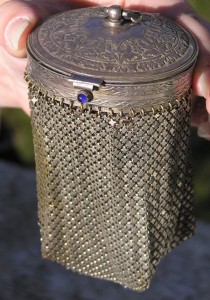 On Saturday I got my first real antique purses — and, as usual, I’m obsessing over researching what I can about them. Today I’m going to inform you about the fascinating things I learned about antique metal mesh bags by Mandalian Manufacturing Company.
On Saturday I got my first real antique purses — and, as usual, I’m obsessing over researching what I can about them. Today I’m going to inform you about the fascinating things I learned about antique metal mesh bags by Mandalian Manufacturing Company.
First a bit of history.
Armor mesh bags by Mandalian are as sought after as those by Whiting & Davis. Though, admittedly, metal mesh and chain had been used for quite some time, Whiting is often credited for having developed the technique for the first mesh bags in 1892. He then partnered with Davis in 1896 and when the mesh machine was invented in 1909, Whiting & Davis acquired the patent. This not only affected the cottage industry of women who hand soldered the up to 100,000 links per bag, but limited big business. However, companies keep trying because the metal mesh bags were only becoming more popular.
One of these was Sahatiel Gabrabed Mandalian, an Indian immigrant * who was focused on quality more than quantity. This is noted in A) the remaining purses themselves; B) the quantity of advertising (Whiting & Davis papered the world promoting their larger production runs, while Mandalians’ ads and inventory were much fewer in number)’ and C) the number of patents Mandalian held — with quite a few in metal mesh and enamel application, as well as jewelry and other accessories.
One of the ways Mandalian separated his mesh bags was with the invention of applying crushed fish scale to the mesh, creating a ‘pearlized mesh’ the company promoted early on, as this vintage tag shows, Color-Vision-Bag, Trade Mark, Process patent Pending
However, the name most of these vintage bags sold under was Lustro-Pearl, exhibited here by this Mandalian mesh purse with original box and tag.
But fashion accessories weren’t the only things Mandalian envisioned — for his Lustro-Pearl, or his mesh metal. In the May 19, 1931, issue of Exhibitors Forum (page 6), this news:
“Lustro-Pearl” New Metal Type Screen
A new type metal mesh projection screen, known as “Lustro-Pearl,” has been placed on the market by Mandalian Manufacturing Co., of North Attleboro, Mass.
The advanced features claimed for this new screen includes: A surface treated with the purest of known chemicals, entirely free from gloss, eliminating all distortion to ordinary types.
Highest reflection factor known to reputable light testing laboratories, effecting a considerable saving of electric current.
Constructed so as to distribute sound very clearly and uniformly throughout the entire theatre.
Can be washed with hot water and soft brush without injury to its surface.
Affords clear view of any picture from any angle of observation, eliminating eye strain or discomfort to patrons.
Surface may be sprayed periodically for many years, and for this purpose, the company plans to loan for a period of ten years a complete up-to-date spraying outfit with each screen purchased, and furnish chemical solutions from time to time for resurfacing this type of screen.
Its high reflective qualities bring out objects in a manner which might be termed the nearest approach to three dimensional pictures, the company claims.
RKO Proctor’s 58th Street, New York, is among the first houses to install this new type of screen.
(This patent, #1,890,819, was issued December 13, 1932.)
But eventually even the better made and more stylized mesh bags by Mandalian couldn’t compete with Whiting & Davis who, by 1944, added Mandalian Mfg. Co. to their list of competitors they’d bought out. Sahatiel G. Mandalian would pass away just five years later.
I could find no record of whether or not that included the film projection screens — or if that business had folded long before 1944. Any info is appreciated!
*
UPDTATE: Per comments, Sahatiel was not Indian but an Armenian immigrant born in Constantinople, Turkey.
Let’s Talk Disney Princesses
About 15 years ago, I sent a letter to Disney (on behalf of my Disney stock-owning and Disney-loving daughter) demanding that they diversify their stock of Disney characters and stories.
Among other things, I suggested they make stories about adventurous mice, a la The Rescuers, who either didn’t all sound like white folk or who helped more than white children — both maybe. And I said they ought to include princesses of color in their films — and that maybe these princess didn’t have to be exclusively limited to exotic locations, like Princess Jasmine.
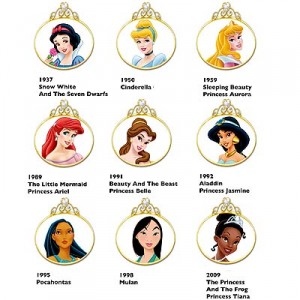 Since this letter of mine, there has been Pocahontas & Mulan, each’s ethnicity presented as exotic and distant via the pageantry of location and historical period as Jasmine. But now there’s the first black Disney princess, Princess Tiana in The Princess & The Frog.
Since this letter of mine, there has been Pocahontas & Mulan, each’s ethnicity presented as exotic and distant via the pageantry of location and historical period as Jasmine. But now there’s the first black Disney princess, Princess Tiana in The Princess & The Frog.
(I know this sounds like one of those new Windows 7 commercials — but If I had any affect on The Mouse, it took 15 years to get past the corporate layers of white defenses.)
Tony Award-winning actress Anika Noni Rose is the voice of Princess Tiana and she’s excited, telling People magazine, “This feels amazing. Not only is [Tiana] the first black princess, she’s the first American princess. So, the scope and the significance is larger than people even realize.”
Apparently Rose is so excited that she’s forgotten that Pocahontas was a Native American. While the ‘princess’ title may be debatable and the treatment of Native Americans is deplorable, is Pocahontas’ status as American really questioned?
If your daughter is a Disney princess fan — and you meet the other requirements — maybe you’d like to be on The Tyra Show:
Does your little girl love Disney princesses? Is she eagerly anticipating the arrival of the first black Disney princess, Princess Tiana? Have you always wanted to take your daughter to Disney World but have never had the means? Do you have an emotional story to share?
Emmy Award Winning Talk Show is looking for deserving moms and daughters who love Disney Princesses! Daughters should be ages 7-11. Must be available Tuesday, November 17 and the following Thursday to Friday.
My kids are all past Disney princess, but my niece isn’t (and my nephew is half charmed by them, half held hostage by his older sister’s demands). But even if there weren’t Disney kids in my clan, I’d still be glad to see an African American Disney princess. Because fairy tails may not come true, but believing in the magic of them is so much easier to do when folks look and sound more like you; not to mention what this does to those with delusions of white superiority.
Whatjamacallit Wednesday: Soap Opera Challenge, Y&R Edition
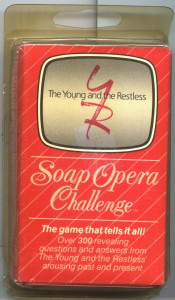 Hubby grabbed this 1987 Soap Opera Challenge game for me at a rummage sale this summer for a buck or two and I’ve just now gotten around to attempting to play it.
Hubby grabbed this 1987 Soap Opera Challenge game for me at a rummage sale this summer for a buck or two and I’ve just now gotten around to attempting to play it.
This particular game in the series by The United States Playing Card Company is based on television’s The Young and the Restless daytime soap. There were several others in the series — and had I either the As The World Turns or Guiding Light versions, I might have fared far better… As it is, my puny knowledge of the Y&R was limited to either my high school summers (1979-1982) when my sister insisted upon watching it because she discovered that the show’s fictional Genoa City, Wisconsin, was based on the very real — and visited — Lake Geneva, Wisconsin, and a few episodes in my freshman year of college (1982-83), when the boys in the dorms insisted upon watching it. (Though most of them locked their dorm doors and pretended not to be ‘home’ whilst watching the show, Y&R had a huge male following at the University of Whitewater; mostly the same guys who watched pro-wrestling, so no surprises there, really.)
Anyway, since the Soap Opera Challenge games are, as you’ve likely surmised, trivia games, my lack of viewing of the soap itself, especially around 1987, impedes my ability to play the game with any success. If you were a fan you’ll likely do much better — though that’s not saying much, because I stink.
However, I endeavor to be fair in my reviews and my lack of knowledge isn’t the game’s fault. While pretending that can fathom just who Jack Curtzynski is/was and so make a guess as to who his first wife was won’t quit cut it, I will focus on the game’s play.
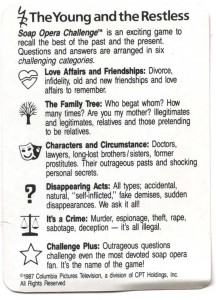 The game itself consists of a game die and deck of 54 question & answer trivia cards, categorized as Love Affairs & Friendships, The Family Tree, Characters & Circumstance, Disappearing Acts, It’s A Crime, and Challenge Plus (“Outrageous questions challenge even the most devoted soap opera fan. It’s in the name of the game!”). Each of the six categories is represented by it’s own icon (Broken Heart, Tree, Theater Masks, Question Mark, Scales, and a Star, respectively) which are then repeated on the game die.
The game itself consists of a game die and deck of 54 question & answer trivia cards, categorized as Love Affairs & Friendships, The Family Tree, Characters & Circumstance, Disappearing Acts, It’s A Crime, and Challenge Plus (“Outrageous questions challenge even the most devoted soap opera fan. It’s in the name of the game!”). Each of the six categories is represented by it’s own icon (Broken Heart, Tree, Theater Masks, Question Mark, Scales, and a Star, respectively) which are then repeated on the game die.
Here’s how it’s played:
Two or more players gather. Each rolls the die and the player who rolls the Star goes first.
Game play begins with a (fresh) roll of the die. The player to the right of the die-rolling player picks a card off the deck (with questions facing ‘up’) and asks the question which corresponds to the icon on the die. If the question is answered incorrectly, the card is placed at the bottom of the deck and the player on the right begins their turn. If the question is answered correctly, the roller keeps the card and rolls again until she gives an incorrect answer.
When there are no more remaining cards, each player counts the cards they ‘won’ and the player with the most cards (correct answers) wins.
There also is a Solitaire version of play. In this version, the player draws a card from the deck, rolls the die to determine the question category, and takes a stab at answering 54 questions (one question off of each card). Cards answered correctly are placed to create a ‘yes’ or ‘correct’ pile; cards answered incorrectly are placed to create a ‘no’ pile. After going through the entire deck, the player counts all the number of cards in the ‘correct’ pile:
If there are 27 or more cards in the ‘correct’ pile in front of you, you are a winner and a devoted soap opera fan.
If there are less than 27 cards in the ‘correct’ pile, don’t take it to heart, these questions are truly a ‘Soap Opera Challenge.’
Again, I can’t really experience the joy of playing, let alone winning, this game; but if you are a Y&R fan — who knows the show’s history — I can’t see why you wouldn’t dig it. A gaggle of giggling girl’s night guests who know the soap opera’s score (and who scored with whom) would have fun; and lonely girls with a half-gallon of ice cream could distract themselves well enough.
And, if all else fails, you could turn it into a drinking game by having the loser take a shot for failing. Just be sure that stinky players such as myself do not drive themselves home.
Of Monday Movie Memes & Media Use
This week’s Monday Movie Meme is Deep Impact: Movies That Have Changed Your Life:
Our blogging buddy Cardiogirl wanted to know if we had ever covered movies that changed our lives or our world view.
Fundamentally, I don’t believe movies — or any media, for that matter — makes people do anything. I don’t think films have changed my life. Or yours. Enhanced your life, sure; if you’re lucky (and smart), movies have provoked thought; but primarily, because people mostly choose what they watch and therefore their selections are based on notions previously held, films confirm what you & I already know or believe.
Seeing that in pixel-ized print makes me rethink why I bother writing then… Rather depressing. So I take another look at the challenge. “What movies had such an impact that they caused a change in our behavior, beliefs, or exposed us to a new passion?”
Ah, that last one — that’s the ticket! Movies and media can expose us to new passions. They can, if we are open to learning, educate us and inspire us to find out more about something we were ignorant of before — and that may include facts or plights presented in such a way that they open our eyes to a new position or point of view.
 In that sense, Debra Chasnoff‘s documentary, Deadly Deception: General Electric, Nuclear Weapons, and Our Environment, opened my eyes and I changed my behaviors; to this day, I won’t buy anything made by GE. Not even a light bulb.
In that sense, Debra Chasnoff‘s documentary, Deadly Deception: General Electric, Nuclear Weapons, and Our Environment, opened my eyes and I changed my behaviors; to this day, I won’t buy anything made by GE. Not even a light bulb.
And if I’m forced to buy a GE product because it’s the only option on the shelf, I rant about babies born without skulls.
And then there was Mississippi Burning. That film had a profound impact on me spiritually. (Please note that this is not a review of the film, nor a commentary on it’s historical accuracy or depictions of reality; just about my personal epiphany.)
Prior to renting the film (shortly after it’s home video release) I had known of the events it was based on, namely the real-life murders of three civil rights workers Michael Schwerner, Andrew Goodman and James Chaney; as I said, we are drawn mainly to those things we know &/or already believe in, so I was drawn to a film about civil rights, equality, and humanity (and its converse). But after inserting the tape, once seeing the date on the screen, “June 21, 1964,” in white letters on a black screen, I was shocked. That date was news to me.
I know I didn’t know that exact date because I would have remembered it; it’s my birthday.
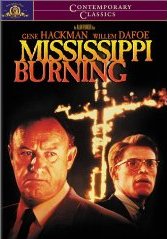 The fact that I was being born while those men were murdered shocked me; the next few minutes of the movie blurred (don’t worry, I rewound it and starting the film over) as I checked in with my spirit, my soul… And then, in a moment of crystal clarity, I knew.
The fact that I was being born while those men were murdered shocked me; the next few minutes of the movie blurred (don’t worry, I rewound it and starting the film over) as I checked in with my spirit, my soul… And then, in a moment of crystal clarity, I knew.
I knew that my profound pain and connection with civil rights issues wasn’t just because I was a nice person or something. It was more than that.. Deeper. It was due to the fact that I could not join my house of flesh on this plane while those souls suffered their way out of it and not be touched by it.
You can call me crazy for such thinking; many do. And you’d be correct to hold me accountable for such thoughts, not those who made the film. Because I still argue that these films didn’t change me; I changed me.
Yes, the facts opened my eyes — because my mind was open to being informed — and I took action (or belief) because my values (and sensitivities) dictate I must. And so I have to take as much — or more — responsibility for my actions than I’m willing to give to media creators for their efforts.
If all of this seems contradictory, or like I’m splitting hairs, it’s because I think we need to draw these lines for ourselves.
I am thankful my college professor showed us Deadly Deception; and I feel blessed to have learned a fact that somehow clarifies spiritual holdings in Mississippi Burning. I admire all involved in those projects greatly (and those sentiments are equal to the feelings of mourning sickness both projects inspire). But if I hand over the responsibility for my actions to anyone, I run big risks. So do you.
We run the risk of expecting people to plop things in front of us, rather than owning our responsibility to be seekers.
We run the risk of relaxing our personal accountability for our own actions, placing blame & credit alike on others for what we ourselves do or fail to do.
So splitting these hairs isn’t cosmetic or even a matter of semantics; it’s about ownership of our actions, beliefs, and passions. This distinction between ‘media which moves us’ and the actions we opt to make is incredibly important.
‘They’ can bombard & pressure us all they’d like, to buy shoes, kill people, vote for candidate A, believe the religious rhetoric of god B, drink beer, mutilate ourselves in efforts to be ‘beautiful’; but we make the choices. We must accept our personal accountability for those choices.
We consume media, and we are what we eat; but in this case, we need to know that we digest in order to properly digest it. And to digest it, we must be diligent in our seeking and consumption of media; as equally open to ideas and points of view that counter our own as we are critically thinking about what we see/hear/read.
Great films, or crappy ones, great books or crappy video games, do not make us do things. We do.
Cowgirl Bandits My A**
A quick tip of my hat to Eliza at Bust Magazine‘s blog for pointing out what a hideous idea it is to make a a new younger version of the film classic Thelma and Louise. The train wreck, set to star Leighton Meester and Amber Heard, is titled Cowgirl Bandits — a title which certainly seems to sum up the producer’s ignorance of just what is truly at the core of this film.
Adding to the inappropriateness Eliza expressed, it is, in my estimation, not simply a bad idea due to the celebs involved (for I don’t view either as an actress anywhere near the likes of either Susan Sarandon or Geena Davis), nor is it a lament that classics ought to be left the hell alone (Did we learn nothing from the remake of The Women?!); no, the horror of this cinemacide goes far deeper.
What is sexy about this film (and I mean that in both the physical arousal definition of the word “sexy” and the intellectual turn-on implications of the colloquial usage) is the very thing they are undoing by attempting a “younger” version. A younger version of the film requires the characters be too young to believably have the character of the film characters.
At 20-ish, you don’t have years, decades, of boredom and abuse in a marriage — and if you even have to ask how a relationship can be both boring and abusive, then you are the “too young” I speak of — so how can you be courageous enough to walk out of it, Thelma? Courage, after all, is measured by the ability to confront a situation aware of the risks, pain, intimidation. (And how young would Brad Pitt’s character have to be– 12?! Or in this hip young version, would she hook-up with an old dude, of say 40? A Brad Pitt role reprisal?)
At 20-ish, you don’t have years of hiding out, sheltering yourself as you live in the quiet silence of a pretense that keeps you at arm’s length from any respite, a deer perpetually in the headlights, exhausted from swallowing the injustice as you remain on guard for the next attack. So how then, can you react as you do, Louise? Without your years of suffering, how can there be a sympathetic policeman?
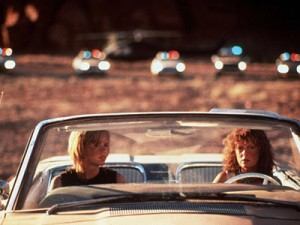 With this pitiful remake, there’s no significant backstory for these characters because — and I know this will offend you young pups — because 20-somethings haven’t lived long enough to have such a history, a history that they have both taken part in the creation of and struggled with for years.
With this pitiful remake, there’s no significant backstory for these characters because — and I know this will offend you young pups — because 20-somethings haven’t lived long enough to have such a history, a history that they have both taken part in the creation of and struggled with for years.
Thelma & Louise wasn’t about some willy-nilly drive into the vague liberation of third-wave feminism partying and screwing the way to a poetic fireball of justice; it wasn’t a movie about women willing to die in the name of feminism. Thelma & Louise was far more complicated — sad and infuriating — because Thelma & Louise were fully developed characters with backstories. And they had to be older to do that.
Cheap Thrills Thursday, Retro Halloween Edition: Barnabas Collins Game
A character in the Gothic soap opera television series, Dark Shadows (1966 – 1971), Barnabas Collins was a long-suffering vampire — tormented both by his status as a blood drinker and his doomed romance with the beautiful Josette. But none of this really matters when it comes to playing the Milton Bradley Barnabas Collin’s game; it’s just a “scary” game for the kiddies.
I only paid $1.50 for the game (# 4003, copyright 1969, Dan Curtis Productions, Inc.) at a thrift store; the original store price tag was $3.99. (Ha! Take that, inflation!)
Our game is complete, save for the toy fangs which, while originally included in the game box, were “not part of the game” and ” to be used by the owner of the game when playing the role of Barnabas” (printed inside the box’s lid — twice). Of course, kids being kids, there’s also the proviso that “they should be washed before a player uses them.”
The game is rather like hangman — at least visually. Only instead of trying to spell words, you spin the spinner and try to build your glow-in-the-dark skeleton by “hanging” him, piece by piece, on the cardboard scaffolding.
Each of the 2-4 players takes a turn spinning, hoping for the chance to collect bones/parts from the coffin. In order to begin building your skeleton, you’ll need either the skull or the body piece; so the first few spins can be anti-climactic. When the spinner lands on the ring, it’s like a wild card; the player chooses any bone, skull or body piece from the coffin.
 But beware, you could land on the wooden spike space! When you do, you’ll need to take a wooden spike from the coffin; collect three of them and you’ll need to remove a bone from your skeleton (and then you may return the three spikes as well). There is an “advanced game” option, in which the player with the three spikes may challenge a player of his/her choosing to a “Vampire Duel.” (They take turns spinning to see who will spin the ring space first. If it’s the challenger, the s/he doesn’t lose a bone; the challenged player does. If the challenged player wins, the challenger must remove two bones from their skeleton.)
But beware, you could land on the wooden spike space! When you do, you’ll need to take a wooden spike from the coffin; collect three of them and you’ll need to remove a bone from your skeleton (and then you may return the three spikes as well). There is an “advanced game” option, in which the player with the three spikes may challenge a player of his/her choosing to a “Vampire Duel.” (They take turns spinning to see who will spin the ring space first. If it’s the challenger, the s/he doesn’t lose a bone; the challenged player does. If the challenged player wins, the challenger must remove two bones from their skeleton.)
As game play is based upon the spinner, there’s very little strategy involved (other than having luckily guessed to use your wild ring spin to get an upper arm when your next turn gives you the lower arm, etc., it’s all chance), making it rather simplistic (even for the ages 6 to 14 stated on the box). But it’s certainly a cheap thrill — on any day of the week.
And it’s cool for Halloween — though it’s not anywhere as scary as indicated in the original television commercial (I doubt it was seen as scary then either). But before you watch it, here’s an FYI: if you’re a Dark Shadows, Gothic fan, or just a Johnny Deep nut (perhaps all three?), Depp’s apparently signed to play Barnabas Collins in Tim Burton’s film adaptation of Dark Shadows.
Now for the word from our retro sponsor:
http://www.youtube.com/watch?v=c16h616Fw0A
This Just In… Timeless Television
When I’m not busy killing squirrels & scaring neighbors, I’m researching & writing from home — in between the usual parenting & home life disturbances.
 Today, while researching a vintage plastic donkey (don’t worry, you’ll hear about it all later), I am absentmindedly aware that my son has left the TV on and that an old episode of The Family Feud is playing on GSN.
Today, while researching a vintage plastic donkey (don’t worry, you’ll hear about it all later), I am absentmindedly aware that my son has left the TV on and that an old episode of The Family Feud is playing on GSN.
It’s that final round, and it goes like this:
Richard Dawson: Name something that little boys like that little girls don’t.
Male contestant: Balls.
The audience snickers through the rest of round.
I do believe that when it came time for the “survey sez” that “balls” got bupkiss. But that’s not the point, now, is it.
An Ugly American Watches A Beauty Pageant
After an incredibly busy & exhausting weekend (this was just part of it), I spent a few hours just loafing on the couch Sunday night. Channel surfing, I happened upon the Miss Universe Pageant — I wouldn’t have watched, expect for they were announcing that the female part of Spidey, Heidi Pratt, would be performing a song. Like Scooby-Doo, I say, “Guh?!”
She can’t sing’ she can’t dance — she can barely put more than three moves together & looks like a clomping horse (no offense meant to horses!) while doing it. Don’t believe me? Watch it.
But by the time her performance was over, I was hooked on the train wreck qualities of the show.
Aside from Dean Has-been Cain (and Heidi, who I wish would just go away) the only person I recognized was Tamara Tunie — which surprised me because I’ve always seen her play intelligent women (a lawyer on As The World Turns; a coroner on Law & Order: Special Victims Unit). When Tunie and others asked their questions, they did try to bring up important issues:
- Should AIDS testing be mandatory?
- How does it feel to compete in a pageant wearing a bathing suit when some women are not allowed to wear bathing suits?
- Are women equal to men?
- Has being beautiful meant you have been taken less seriously as a business person?
Watching the contestants struggle to not answer the questions, to avoid the meat of the issue, was painful. It would be easy to call them robotic Stepford wives, but honestly, how could any of them answer the question directly (let alone honestly) and win the competition?
Watching them give placid answers designed to inflate the room’s already high testosterone levels was to witness a horrifically powerful thing.
http://www.youtube.com/watch?v=_-LF9Y4SqdU
It reminded me of the unspoken issues we women have to keep mum about — or risk loosing what places, ground, we have as well as those we aspire to. Watching beautiful young women play that game in a pageant setting was astonishing. Especially in front of La Donald, Mr. Trump. :shudder:
But there was plenty to enjoy too — if your enjoyment, like mine, tends towards the perverse.
I enjoyed the fact that at least one contestant didn’t take not moving on up with the ever shortening list of finalists as gracefully as she’s supposed to. Look at Miss Switzerland’s sad slump of despair!
I enjoyed watching when Miss Venezuela won — making “history” by giving back-to-back wins for Venezuela in the Miss Universe Pageant — and the former Miss Universe was so excited that she threw the 2009 Miss Universe crown off & over the winner’s head. (This is different coverage than I saw, but you’ll see the crown fumble — and note the unfortunate caption “clinches the tit” as the word title is shortened.)
In looking for photos from last night’s pageant, I found a great number of complaints about the racism in the Miss Universe pageant — especially with regards to Asian women. I haven’t watched a beauty pageant in probably 30 years, so maybe I shouldn’t take the claims as true… But it sure looks like nothing has changed. Except for the internet providing more place for public outcry against the Miss Universe Organization, predictions of which countries will no longer participate, and viewers vowing to switch to other pageants like Miss World.
If I am allowed to make one “purely girlie” observation (one more likely to please La Donald), it’s that Miss Kosovo, Marigono “Gono” Dragusha, is nearly as externally beautiful as Audrey Hepburn. Not only does she physically recall Hepburn, especially around the eyes & in her ball gown performance, but I believe she had stated that she intends to become a counselor to help children affected by the violence in her country. (Miss Kosovo finished as the 2nd Runner Up, aka 3rd place.)
I don’t have any plans to watch another pageant; but then again, I didn’t plan to watch this one… I do think checking in every 30 years or so might just be enough.
Cheap Thrills Thursday: The Joys Of TCM, Bathing Beauty Edition
I’m not about to go all mathy on yer arse, but in a world of streaming video, on-demand downloadable rentals, home delivery rentals (even without fees!) TCM, part of basic cable, which is bundled with my cable internet connection, is one of the greatest cheap thrills I can get.
Films shown uninterrupted and commercial free, save for a few sponsored reminders to things you probably want anyway (like the TCM Now Playing Guide) — it’s the way TV ought to be. (And here is where I will insert my continual plea that TV return to its original format of corporate sponsored programs, with mentions at the top & bottom of the hour, as opposed to junky ads & product placements — which, in the case of the former, only distract & cause me to leave the room and, in the latter, go unnoticed by me anyway.)
Anyway, TCM is an incredible value.
 Along with Robert Osborne and, now, Ben Mankiewicz‘s informative tidbits, you get to watch films you adore and see films you’ve never seen — including those that aren’t available anywhere else & those that you’ve avoided before because of crappy trailers & promotions that made you think they were crap. Now, thanks to TCM, you can watch them and either fall in love or be glad you didn’t waste money on a rental, download, or whathaveyou.
Along with Robert Osborne and, now, Ben Mankiewicz‘s informative tidbits, you get to watch films you adore and see films you’ve never seen — including those that aren’t available anywhere else & those that you’ve avoided before because of crappy trailers & promotions that made you think they were crap. Now, thanks to TCM, you can watch them and either fall in love or be glad you didn’t waste money on a rental, download, or whathaveyou.
All of this brings me to the case in point: Last night’s viewing of Bathing Beauty.
As a kid, I’d never seen the Esther Williams films — but I saw the various parodies & heard the not-so-flattering commentary about the kitsch of synchronized swimming and pageantry of the old dated swimming movies. Ditto my kids, who aren’t interested in humoring me enough to let me rent one for movie night. But thanks to TCM, I got to watch Bathing Beauty last night.
The film is as sweet & simple as you’d expect a film from the 1940’s to be; romance and humor, with Red Skelton a complete joy as the young man willing to do anything — even be the only (tortured for demerits, forced to crossdress) male at an all girl’s school — to get his beloved back.
Unexpected were the lengthy scenes of musical performances from Harry James and his orchestra, Xavier Cugat, & others in traditional, glamorous nightclub settings; vicarious home front war living for those who couldn’t afford evenings out.
Now I loves me some Cugat, but the pee-my-pants-with-delight moment was a scene early on in the film, when the campus girls force (by flattery & girlie whining) one of the music instructors to play some forbidden music…
Here Ethel Smith plays the organ — note the lavish visual of her dainty feet, in pretty pumps, skimming along the peddles (Foot fetishists, beware! I’m not responsible for what this does to you!)
[youtube]http://www.youtube.com/watch?v=4JkhpxzLIFQ[/youtube]
After that warm up, Smith consents to show the kiddies — ooops! I mean the girls — more of her chops on the electric organ, playing her theme song Tico Tico.
[youtube]http://www.youtube.com/watch?v=TA9qlWyk-7Q[/youtube]
Ahh, a fantastic orgasmic ode to the organ — and fashion (love her ensemble!). But if that’s not incentive enough to watch Bathing Beauty &/or TCM, how about Skelton as a ballerina?
[youtube]http://www.youtube.com/watch?v=R39DLTMlGSE[/youtube]
Seriously, all of this is so fantastic, I was nearly exhausted by the time we go to the results of all the cumulative efforts — the big swimming pageant. Which was as over-the-top as the parody legends proclaimed. Oh well, I have to leave you with something to look forward to.
The Fear Filled Prophecy For The Monday Move Meme
This week’s Monday Movie Meme topic is “fear.” I don’t particularly enjoy being scared; life is scary & fragile enough, thanks. Nor do I find any entertainment value in repeated bodily harm & numerous deaths — no many how many forms the gore takes. So I obviously do not watch many horror or slasher films. But I have managed to see some though — like I was there (with my mom) to see the original Halloween (1978) and I think I saw at least one more part in the classic horror series… Mom needn’t worry that I’d be up late with nightmares because, gross as the films were, they were rather forgettable to me.
But then I saw Prophecy (1979). Nothing, I mean nothing, had scared me as profoundly as that film.
 Prophecy is about a burned-out inner city doctor (Rob, played by Robert Foxworth) who is given the chance to escape to the country (Maine wilderness) for some meaningful (70’s hot issue) environmental science by investigating a dispute between a paper mill and the local Main Indians. He takes along his classically trained musician wife (Maggie, played by Talia Shire) — because there’s an important personal (and another political 70’s) sub-plot involving the couple: the embittered doc doesn’t want to bring another life into this horrible world, and she’s not only knocked-up, but isn’t so keen on (what I recall to be) another abortion.
Prophecy is about a burned-out inner city doctor (Rob, played by Robert Foxworth) who is given the chance to escape to the country (Maine wilderness) for some meaningful (70’s hot issue) environmental science by investigating a dispute between a paper mill and the local Main Indians. He takes along his classically trained musician wife (Maggie, played by Talia Shire) — because there’s an important personal (and another political 70’s) sub-plot involving the couple: the embittered doc doesn’t want to bring another life into this horrible world, and she’s not only knocked-up, but isn’t so keen on (what I recall to be) another abortion.
When they arrive in Maine, it’s pulped into your head that a crisis is at hand at the paper mill. It’s the environment vs. progress, land vs. capitalism, with the lumberjacks on one side and the Indians on the other. In fabulous retro kitsch film style, Armand Assante plays the young Native American activist, angrily defending the old world traditions with modern gangsta style; gotta love the irony of a film trying to make points about the wisdom of native cultures using an Irish-Italian actor to play a Native American.
The idealogical & political war has been going on for quite some time now, but things are coming to a head. People are missing and the lumberjacks are certain it’s the Indians who, upset that the paper mill is damaging the land, have taken or harmed the people in the name of politics. But something else is going on… Something just below the surface… And we are shown that literally when a duck, floating atop the water, is gulped as dinner by a fish below…
Long creepy story short, the menace is a native alright; but it’s not exactly human.
The Indian legend has it that the creature is Kataden, there to save them, their land, their way of life — but really, it’s a bear that, due to the paper mill’s dirty pool (poisoning the water pools) has mutated into some sort of hideous & huge bear-pig.
As I too vividly recall, the Native American lore says that the legendary Kataden is a being which embodies “every other living creature” — something scientifically paralleled in a Darwinian theory of fetal development when Kataden’s drowned cubs are found by the doctor who supposes these babies are the results of the paper mill’s mercury poisoning. This made everything all the more “plausible” & frightening to my then 15 year old mind.
Like most horror films, the cast of characters is slow to catch on to the real problem, giving way to lots of violence — violence which serves to bloodily & bodily illustrate all the issues at hand.
Along with the paper mill vs. Indian clash, you have the clash of ways and beliefs between the younger Indians & the older Indians, the corrupt and ignorant/innocent paper mill persons, and the “exploration” of modern life via the personal issues of a modern couple. She’s emotional & artsy (feminine) and he’s all hard(ened) science (masculine), which echoes the other film’s value laden battle themes (nature vs.money, faith vs. pragmatics, traditions vs. modernization, the gift of life vs. quality of life).
The dangers of each are literally & graphically presented in such scenes as one of Kataden’s babies trying to suckle from Maggie’s nipple, the attack on innocence represented as a child in a sleeping bag, and the elderly Indian leader meeting his maker as he smilingly goes to meet his savior, Kataden.
And then there’s the matter of her pregnancy… Will the doc bring a child into this world? Does he have a choice? How much does he resent her — enough to not save her as his masculine protective duties dictate? Has she eaten too much of the mercury poisoned fish? Will the monster bites she’s suffered be a problem? Dogs & cats Bear-pigs & men living together; mass hysteria.
At the end of the film, life is affirmed: nature & femininity wins, overcoming corporate masculine greed with a show of traditional human survival instincts rooted in love. But at the end another creepy creature is seen, suggesting a sequel…
Did we learn the right things? Will the thing grow up, then rise up to teach us something new? Only it’s 1979; the 80’s are on the horizon, our backs are turned on the lessons learned, and no sequel has yet to come.
But I’m unable to forget it all — or the images in my head.
Yes, Prophecy is blunt heavy film — heavy on the cliches, ham-handed in using horror to punching them like a fist to your face to make the point — but it was also effective in scaring the crap out of me & placing issues heavily in my heart.
I’m not sure if “adult me” would be so moved. I did catch parts of it on late night television one night, but I wasn’t prepared to sit & give it it’s proper attention (it was on while I worked to meet a deadline) and it was so edited for content that I felt ripped-off. But I’d really like to see it again and see if it holds any of that old (black & terrifying) magic. It must hold something if I retain it so vividly 30 years later.
Click the pic & watch a clip!
For info, images, quotes, opinions, etc. on this film see BadMovies.org & Kindertrauma.
But Maybe I Should Leave My Fantasies Of Isaac Out Of It
To celebrate National Romance Week, Princess Cruises has joined with Cruise Critic to conduct a search for real-life love stories that have taken place on the decks of Princess ships. Jan Swartz, Princess’ executive vice president, says:
Over the years, we’ve heard many romantic stories from our passengers – everything from meeting their future spouse onboard a Princess ship to unexpectedly reconnecting with someone with whom they develop a new relationship – and so we’re launching a search to find as many of these heartwarming stories as possible.
So why would you confess such things as bumping into an old flame & rekindling a romance aboard a cruise ship, or, a la The Love Boat, hooking up with the ship’s doctor — let alone have them published on the Princess website?
Well, Princess Cruises says it’s for the love of romance — and the prize. (The winner will receive a seven-day Princess cruise to the Caribbean, including airfare.) But I think it’s the opportunity to have Captain Stubing judge your love exploits at sea.
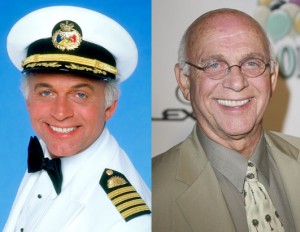 That’s right, one of the judges of this contest is “Princess’ well-known ambassador and member of the line’s ‘Department of Romance’,” Gavin MacLeod.
That’s right, one of the judges of this contest is “Princess’ well-known ambassador and member of the line’s ‘Department of Romance’,” Gavin MacLeod.
MacLeod and Cruise Critic editor-in-chief Carolyn Spencer Brown will pick their five favorite stories from among those submitted, and then the Cruise Critic community will then vote on the top five to determine the most romantic story. Entries will be taken until August 28, 2009; the most romantic story will be announced on September 28, 2009.
I’d like to win a free cruise — who wouldn’t? But I’d really like to impress Captain Stubing. (Maybe enough, along with all the other stories, to reignite a campaign to bring back Love Boat; oh, the many happy nights of watching, giggling, dreaming about Isaac, “My Bartender.”) At least that’s why I would enter — if I’d ever been on a cruise, let alone a Princess Cruise. Donations accepted.
“Just a moment, Janet. We don’t want to interfere with their celebration.” Or Do We?
 The entire Halloween Horror Nights event at Universal Studios Hollywood has been re-designed for 2009 — including a Rocky Horror Picture Show tribute which begins a 16-night run on October 2nd.
The entire Halloween Horror Nights event at Universal Studios Hollywood has been re-designed for 2009 — including a Rocky Horror Picture Show tribute which begins a 16-night run on October 2nd.
Universal Studios Hollywood will present the Rocky Horror Picture Show: A Tribute, featuring Dr. Frank-N-Furter, Riff, Magenta, & the gang, at this year’s Halloween Horror Nights event per an agreement between the theme park and Twentieth Century Fox’s Licensing & Merchandising Division.
Howard Nelson, Vice President Worldwide Promotion for Fox Licensing:
The Rocky Horror Picture Show is more than a film, it’s become a cultural touchstone in American entertainment and this new attraction is yet another testament to its strength. This tribute extends our relationship with Universal Studios Hollywood, which continues to do a great job translating our properties for live audiences.
The new Halloween Horror Nights will also feature four all-new mazes (including, per agreement among Universal Studios Theme Parks, Lionsgate and Twisted Pictures, a “live” maze experience based on the Saw film franchise), a new “Terror Tram” backlot studio experience as well as terrifying new “Scare Zones.” You can keep up with more news & announcements about Halloween Horror Nights’ official Twitter account.
Does Mattel Sock It To Us With Goldie Hawn Barbie?
Speaking of flags painted on Goldie Hawn’s body on Laugh-In…
To celebrate Barbie’s 50th anniversary, Mattel’s 2009 Barbie Doll releases feature a number of iconic retro doll re-do’s & celebrity dolls — including a very accurate version of Goldie Hawn as seen on Rowan & Martin’s Laugh-In. Look at the incredibly detailed reproduction of Goldie’s bikini & body painted tattoos, as seen in 1968:
Part of the Blonde Ambition Collection (officially said to be available July 1st, the Goldie Hawn Barbie is available now at eBay, Amazon
, and a few select doll retailers), Goldie joins Marilyn Monroe as a vinyl delight for collectors.
And this doesn’t offend me in the slightest.
In fact, I want one.
While Babs has often been cursed as the vinyl bringer of doom, providing body image issues to little girls everywhere, I don’t have a problem with a pop culture history reproduction. And it’s not because I’m a collector &/or that Barbie’s boobs have been reduced for the Goldie version.
First of all, the Goldie Hawn Blonde Ambition Barbie is for adults; not kids.
Kids should not be given a doll they do not understand (and that includes the societal context of the times she comes from). Kids also shouldn’t reduce a $40-50 doll to garbage; and let’s face it, Goldie’s tats, understood or not, would be abraded away with childhood play.
We adults already know of Goldie & the cultural context of the time. Our body image issues, however affected & formed, are also our own responsibilities; we are old enough to say to ourselves and the world, “I’m a woman, I look like this, and I’m happy with it.” Or not, as the individual case may be. (And then we should seek help for our own issues, no matter how they were formed; finger pointing alone won’t help us love our bodies or keep them healthy.)
Second of all, as a feminist, I have a long and deep relationship with Barbie.
I played with Barbie as a young girl. And, while my sister thinks it’s so hysterical that she tries to embarrass me with this fact, I have no problems admitting it: I played with Barbies until I was 16. I loved to take pretty vintage handkerchiefs & other bits of fabric and pin them on my dolls, then pose them in little vignettes with the Barbie accessories, in the garden, etc. I was exploring visually, creatively with the tools I had at the time. I couldn’t sew; so I pinned on the fabric. I didn’t have a real camera (and the means to pay for all that film & developing); so I created scenes & literally used my hands to frame the images I’d capture in my mind’s eye — reconstructing, reposing, redressing, until I saw what I wanted.
I could be odd — and this may not be the “most normal” Barbie play; but then, when I see other kids playing with fashion dolls, I see quite a bit of that too… I don’t think my “oddness” stems from how I played — or how long I played — with fashion dolls.
Of course, as I got older I became suspicious of Bab’s and her figure. This was further complicated by media images, feminist discussion, and the fact that I looked far more like Barbie than most of my friends & family did…
I noticed that in books, films, television shows, etc., that the voluptuous women were most often the “evil” ones. We big-busted women were depicted as “man traps” and were not to be liked or trusted by other women either. Our assets were too compelling. We were competition. Our looks garnered looks — and the whole thing was diabolically unnatural (even when it was all so completely natural). It was bad, we were sinful; therefore we were The Enemy.
It was saddening, maddening.
But it wasn’t Barbie’s fault. It wasn’t even Mattel’s fault.
As a society we were sold on beauty & sex appeal, no matter how realistic or not the standards are; but if you dare to have it (and this was something deemed & defined by others, it was not even necessary for it to be exhibited or used by yourself), you were viewed suspiciously… Punished, ostracized.
But it wasn’t something a plastic doll did. And the only reason Mattel and others could sell it was because our culture greedily consumed it. And then made weird judgments about it. WTF.
While some blame Barbie for unrealistic body image, others condemn the doll, her world and her friends for an insipid, unrealistic, & exaggerated sense of romance; I find she exposes even more about our twisted cultural values & expectations. Barbie is a useful tool.
This relationship with Barbie is one I’m still trying to figure out… And the commercial processing of more dolls, how the marketplace reacts to them, and the resulting opines of others could all just get me closer to some better understanding.
Besides, if I don’t like Barbie, I don’t have to buy her — for myself or anyone else. What’s more, I can let her coexist in this world without buying her ideals either.
Fabric Swatch Friday: As Seen On Me
Sew Bettie’s amazing Retro TV Fabric twists “As Seen On TV” into something new — yet retro. Can you dig it?
Police Woman: The Long Octopus Arms Twarting Female Police Detectives
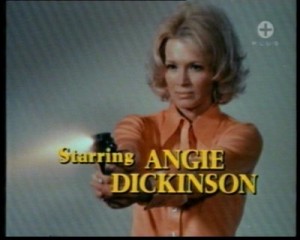 Most of us tend to think of Angie Dickinson when we think of police women — and it’s not just because she was Sgt. Suzanne “Pepper” Anderson on Police Woman in 1974.
Most of us tend to think of Angie Dickinson when we think of police women — and it’s not just because she was Sgt. Suzanne “Pepper” Anderson on Police Woman in 1974.
Most of us tend to think of the 60’s & 70’s when those women’s libbers pushed and sued for the opportunity to be equals (including police officers) and Angie baby was in full mod swing then, so naturally we “see” her as the face (and bod) of the mod we’ve-come-a-long-way-baby policewoman. And the plethora of Police Woman dolls & toys — like this ridiculous “Sabotage Under The Sea” set with octopus — helped solidify this image for a lot of us.
But in truth, there not only were female cops before then, but they were the result of what we’d now call “unlikely feminists” — and some bad male behavior. These battles would be more dangerous than tangling with an octopus.
You may have heard of Isabella Goodwin, the first US woman detective appointed in New York City on March 1, 1912 (it’s the sort of “fun historical fact” people like to blog about, say, on March 1st). But few take the time to give you some real information about her — or at least some cultural context. But you know I’m all about the context, right?
There’s little information available on the web about Isabella Goodwin (save for the fact one-liner), but there is a story & a setting alright.
The story begins in the mid 1800’s when female prisoners were housed with male prisoners and so male officers, their wives, widows of policemen (called “bedmakers,” these women were paid out of the policemen’s own pockets), or “the maid at the police station” performed searches on female prisoners. Such mingling of the sexes shocked the general public — mainly because of the high number of poor men and women who came to New York City often found themselves forced to find shelter at station houses (these people were called “casuals”). According to the NYPD, “in 1887, at various times, up to 42,000 of these homeless women spent at least one night in a station house.” However, things were about to change.
The Women’s Prison Association of New York and the American Female Christian Temperance Union petitioned the Board of Estimate and Apportionment for the appointment of police matrons, and for the creation of separate prison cells for men and women. If it sounds odd to you that Christian women of the 1800’s would be involved in a feminist push for equal career opportunities, you misunderstand. The push was not for careers for women, but for the protection of women who could be victimized by men. And you must remember that once upon a time, Christians saw their role in society as to help the less fortunate, including through social reform, as opposed to the current day philosophy of “”convert them or judge them & leave them to rot.”
Pressured by groups seeking social reforms, the New York State Legislature passed a law requiring that female doctors treat female patients in mental institutions & that every precinct station house has Police Matrons to tend to female arrestees. This legislation was passed in 1888. But the New York City Board of Police Commissioners does not make any Matron appointments until 1891 — after Governor David B. Hill signed a bill that mandated the hiring of Police Matrons and the establishment of separate cells for men and women under arrest. This was a direct result of a police officer being found guilty the attempted assault of a fifteen-year-old girl at a station house and sentenced to prison in 1890.
Months later, the first civil service test was held for the title of Police Matron — with applicants being required to have letters of recommendation from at least twenty women “of good standing.”
In an attempt at humor, I suppose, Jay Maeder sums up the “new” police matrons with “thus creating the jail-matron system that remained a sinecure for many a stern, stout Irishwoman well into the 20th century.”
:sigh:
Maeder’s stereotype isn’t the worst, or even the first. Gilder Lehrman Institute of American History notes:
Of course the matrons were not installed without criticism, which by the way ranged from the prediction that women would become totally incapacitated at the sighting of a mere rodent to criticism that men wouldn’t stand a chance because women would completely take over, dominating the station house and their fellow male employees.
Police Matrons worked long hours, receiving only one day off per month, and just one week’s vacation per year. In 1896, there is one Matron per shift (one day, one night) per station house. Their duties increase too. Matrons are now assigned to search subjects; process, escort and supervise inmates; and to care for lost children. As of 1899, they were paid $1,000 per year as of 1899, and they would not receive a pay increase until 1918.
It is in 1896 that police widow Isabella Goodwin (noted as having four children) is hired as a Police Matron and begins her police career, which will culminate in making First Grade Detective in March of 1912, and being appointed second in command of the first Women’s Police Precinct in April that same year.
Goodwin’s appointment to detective came about through the Police Chief bypassing Civil Service requirements that discriminated against women — presumably in large part due to pressure from the public and lots of press regarding her role in “bringing to justice of the taxicab bandits,” as evidenced in Goodwin’s interview in The New York Times, March 3, 1912 (below).
You really should read it; where else can you read a real news story which includes characters called Swede Annie and Eddie The Boob?
The old newspaper article also includes Goodwin’s story of a bust of a (male) fortune teller. The problem of $2 readings were apparently quite prevalent, for The New York Supplement details of Goodwin’s testimony & the judge’s affirmation of the conviction of fake fortune teller Maude Malcolm on Janurary 18, 1915 (beginning on page 919).
Goodwin, naturally, ends the interview with a, “Despite my peculiar work I try not to neglect my home. A woman’s first duty is to her family, and I have tried always to remember that.” To which the author is only too happy to pander, prove (with assertions from Isabella’s children & the author’s own eyes) & compliment.
But if this seems, well, less satisfactory than the loud “long way baby” route of the mod 60’s women’s lib ladies, consider the following…
Such public adoration may have been new to Goodwin and to female policewomen at the time, but Jay Maeder notes it wouldn’t stay that way:
Matrons did women pretty much exclusively until 1912, when one Isabella Goodwin, theretofore detailed to the wayward-lass wing of the Mercer St. station, was assigned to take a position as a domestic in a household full of suspected bank robbers. Goodwin, swiftly getting the goods on this bunch, then became New York’s first female detective first grade. Subsequently, more and more women began to get pulled into crime-busting duties, and a full-fledged Bureau of Policewomen was established in 1926.
The city’s lady cops, many of them nurses and lawyers and social workers and other such college-educated professionals, were celebrated public figures all through the 1930s and ’40s and ’50s, always good press copy as they went often quite dangerously undercover to lure sexual predators and smash abortion rings and whatnot.
Isabella Goodwin may never have had a doll or octopus made in her honor; but then again, she was probably never called “a bitch of a detective” in some sort of twisted praise. Angie Dickinson, on the other hand, only played a detective on TV and got the doll, the octopus, the pinup poses in men’s magazines, and had her then-husband, Burt Bacharach, “compliment” her by saying, “”If she’s down a notch from me in the public eye these days, well, she should be up a notch—she’s a bitch of an actress.”
So I ask you, who was the more respected woman? Who should we think of when we think of “police woman?”
And why hasn’t someone made a collectible Isabella Goodwin doll?
Maybe instead of an octopus accessory, it can have a fake fortune teller accessory kit.
Ah, The Sights & Sounds Of 80’s Flicks
The Monday Movie Meme is I love The 80’s; here are some of my quick thoughts on my favorite 80’s films…
Desperately Seeking Susan — I was dressing like slutty Madonna; but like Rosanna Arquette’s Roberta Glass, I wanted more of Madonna’s life (as Susan, anyway). I recently watched the movie again, and felt the same stirrings now. Still a cheap, fun thrill!
The Lost Boys — Still an excellent film. A great blend of adventure comedy with enough chills & thrills to make you grip your boyfriend’s arm. Of course, Jami Gertz & Jason Patric gave you chills & thrills of a different sort (and maybe that lead to different sort of grips between you & your boyfriend… I’m not judging you if it did.)
I wore out my cassette version of the soundtrack; had to get it on CD.
Pretty In Pink — Molly totally chose the wrong guy. How can anyone turn down The Duckman?! His performance of Otis Redding’s Try A Little Tenderness, & the rich kid was forgotten. Yes, I know that song was lip-synced; but I melted. (Jon Cryer, as Duckie, did sing Love in the film though.)
[youtube]http://www.youtube.com/watch?v=z727wXHEJMg[/youtube]
James Spader was in the film too — as the rich jerk you loved to hate. Too pretty for me to like him then, it was too easy to lump Spader into the group of vain guys who thought they were better than me.
But…
Along came Secretary & then Boston Legal, and I completely, utterly fell in love with Spader. He’s on my list of “people I’m allowed to ‘do’ if I ever have the opportunity.”
I may have to write more about my love affair with James Spader later.
The Breakfast Club — This time Molly Ringwald got the guy right; but somehow, I knew that once she drove off with her (movie) dad, she’d forget all about Judd Nelson…
I wouldn’t.
Judd was never hotter. (I know because I kept waiting for him to appear so hot again. :sigh: I still wait.)
But to me, the ultimate 80’s flick is Valley Girl. If I couldn’t be brave enough to live life as Madonna’s Susan, well, I’d get me Nicolas Cage, the dangerous yet misunderstood “bad boy” who’d love me, even if I would have uttered “gag me with a spoon” — which, trust me, we only said to mock those we felt were lame enough to say that… I don’t think anyone ever said that outside of a movie or a cliché.
Actually most of the movie is cliché. But it’s the height of cliché! It’s full of romantic cheese done with an incomparable stylistic edge set to Modern English’s I Melt With You, yet (and loads of other greats on a kick-ass soundtrack).
[youtube]http://www.youtube.com/watch?v=Hb-a2jrbQAQ[/youtube]
David Carradine’s Death In My Husband’s Newsfeeds, It’s Not Just For Breakfast Anymore
Hubby was reading to me from his newsfeeds about the latest news on David Carradine’s death, saying, “Rumours Carradine died attempting auto-erotic asphyxiation–”
I interrupt with a righteous, “Go old guy!”
Hubby, ignoring me (as most interrupted husbands are wont to do), continued to read, “– where victims achieve heightened sexual pleasure by restricting their air supply – are backed up by a quote a Bangkok police officer gave to British newspaper The Sun… urm.”
My response? “Well anyone who talks to The Sun can be trusted; it says so in the Bible.”
“Oh!” Pause. “Oh, no…”
“What?” I ask.
“Well, this one says, ‘Did David Carradine die as the result of a sex game? (with photo gallery)’ — but I don’t think it’s that sort of gallery.”
“That would be creepy-cool. Like, ‘Here’s Carradine getting blue…bluer… bluer yet…'”
This is when hubby has to make a choice: laugh at/with me, or leave the room. He laughs.
And I know it’s grim & rude to laugh at all of this; but remember, we aren’t laughing at Carradine’s death — we’re laughing at the coverage of it.
And it’s not like any of us didn’t already make the jokes about Carradine dying from Pai Mei’s Five-Point Palm Exploding Heart Technique.
Does Sparkle Shine?
I’d never heard of the movie Sparkle. Maybe because in 1976 I was a white tween, getting my fill of film angst from The Bad News Bears (gawd I knew just what Jackie Earle Haley’s Kelly Leak wanted — and what Tatum O’Neal’s Amanda Whurlizer couldn’t give him!); I don’t know. But the list of names which accompanied the title on the cable’s info screen was intriguing…
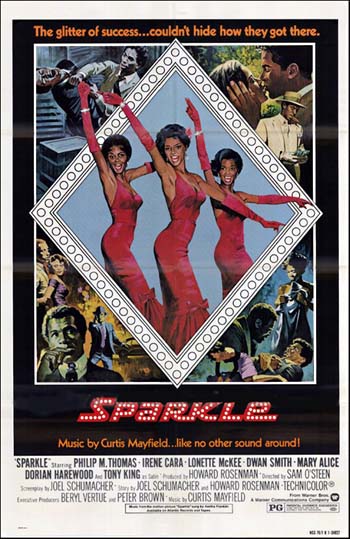 Philip M. Thomas (later Philip Michael Thomas, the pretty one of Miami Vice fame), Irene Cara (Fame), Lonette McKee (a beauty whose career credits include The Cotton Club, The Women of Brewster Place & Jungle Fever), Mary Alice (an actress I don’t think has ever been given proper attention or credit — save for, perhaps, at Stinky Lulu’s), Dorian Harewood (a man who has been in so much it’s ridiculous!), & Beatrice Winde (a great character actress you’ll recognize on the spot).
Philip M. Thomas (later Philip Michael Thomas, the pretty one of Miami Vice fame), Irene Cara (Fame), Lonette McKee (a beauty whose career credits include The Cotton Club, The Women of Brewster Place & Jungle Fever), Mary Alice (an actress I don’t think has ever been given proper attention or credit — save for, perhaps, at Stinky Lulu’s), Dorian Harewood (a man who has been in so much it’s ridiculous!), & Beatrice Winde (a great character actress you’ll recognize on the spot).
So, even if Sparkle was a retro train wreck of a film — especially if it was a retro train wreck of a film — I had to watch!
Sparkle (1976) is approximately a twenty year old film which takes place approximately twenty years earlier, in 1958. Got it? Good.
The movie tracks the lives of three young sisters — biological sisters — from Harlem: Sister (Lonette McKee), Delores (Dwan Smith), and Sparkle (Irene Cara).
The eldest, is Sister, “the prettiest girl in Harlem.” And she knows it. She’s gonna be trouble for single mom, Effie (Mary Alice) — something Effie’s friend & Harlem busy body, Mrs. Waters (Beatrice Winde) is only too happy to warn the matriarch about. When we meet Sister, she’s being courted by the handsome but fast & criminal-element-attached Levi (Dorian Harewood).
Sparkle, the quintessential good girl, adores her older sister. Sparkle is 15 and never been kissed — until Stix (Philip Michael Thomas) steals a few while she’s getting the laundry off the roof.
The middle daughter is Delores, a good looking young woman whose beauty & strength are over-shadowed by the chips on her shoulder. Yes, that’s “chips” plural. Because Delores isn’t just the morality preaching (annoying) middle child who feels duty bound to correct both her older sister (commenting about Sister’s straightening her hair to look like Marilyn Monroe) and her younger sister (threatening to be a tattle tale about Sparkle’s kiss on the roof). No, Delores also has a sassy mouth she uses to lip off to mom with regarding mom’s work as a maid.
Delores: We’re old enough to iron for ourselves. You ain’t our maid.
Effie: I always iron clothes for the ones that I love.
Delores: I suppose you love them crackers that you work for?
Effie: You watch your mouth. Now, go get your homework before I give you a sign in a place you won’t forget.
So, you’ve got three very different siblings.
Yet they come together, at Stix’s urging, to form a singing group — first with Stix and Levi , as The Farts Hearts. (Hey, the MC made that corny slip; I’m just quoting it! The MC also had other stale jkes, such as, “You all heard about the Cookie sisters? Lorna Doone and Nuthin’ Doone!”)
The Hearts are a hit, especially with Sister’s sexual enticing of the audience, but then, because sex sells, Stix promotes the sisters as an all female group, Sister & The Sisters.
 Unfortunately, as the singing trio begins to become popular, Sister catches the eye of Levi’s gangster boss, Satin (Tony King). No good can come of this…
Unfortunately, as the singing trio begins to become popular, Sister catches the eye of Levi’s gangster boss, Satin (Tony King). No good can come of this…
Just as momma warns, Satin drags Sister into the gutter with him. Not just sexually (which wouldn’t exactly be a shock for Sister, or a film which has 15 year old Sparkle messing around with Stix), but she’s beaten by him — and hooked on drugs too. Classic lines (no drug pun intended) include Delores’ concerned & accusatory, “What else has he been pushing into you besides his fist?” and Sister’s pleading, “Can’t you see? Sister can’t fly on only one wing…”
The montages of Sister’s fall are told rather beautifully; even if the story seems clichéd, the telling of her downward spiral while the trio performs Something He can Feel is rather artsy.
In fact, at this point, I’m wondering why the film isn’t called Sister; where the hell is the Sparkle story?
Even poor old Delores has a better plot, a more fully developed character. For, upset with Sister’s weak victim status, Delores gives up her virginity to another of Satin’s cohorts in order to find out about Satin’s plans — which she promptly calls in to the police. But it all goes horribly wrong when the police shoot, then imprison, Levi — who Satin has sent in his place.
Distraught, Delores packs to leave home, where she is caught and engaged in a confrontational conversation with Effie:
Effie: Well, whatever troubles you got here are going right with you and that suitcase.
Delores: You don’t understand, Mama. Like, there’s education like there never was before. Mama, we don’t have to slaves to the white establishment anymore.
We don’t have to live off what the white man throws our way. Thanking him for his chicken-shit pay and chicken-shit jobs. We don’t have to run around shining his shoes and driving his cars and cleaning his floors and being his ma – …
Effie: Go on, now, say it. Being their maid. Hmm?
Delores: Yeah, Mama. Being their maid.
Mama, I seen you, ever since I was a little kid, getting up in the middle of the night to take the subway to ride for two hours to go to their house, to do their cooking and to do their ironing and do their cleaning and wash the shit out of their toilet. And for what, Mama? For WHAT?
Delores may leave with the final word, but you just know, wherever Delores lands, that her failure to save Sister plus get Levi in trouble, will be in that suitcase just as Effie said… And she’ll have the added baggage of knowing that her self-righteous and lame justification were tissue-thin too.
I’m not entirely sure the film should have ended right there… There is, after all, Sparkle’s story to consider. Delores’ leaving & Sister’s poor condition combine to leave Stix’s group unable to perform, so he too bails. He offers Sparkle the chance to leave with him, but she’s “the only one left who cares for Sister,” so she stays.
Montages of Sparkle enabling Sister, culminating in Sparkle’s singing at Sister’s funeral.
After the service, Stix, who of course is back in town, visits Sparkle — and this is probably the finest acting I’ve seen from Irene Cara. I’d quote from this scene, but it would read horribly — for it’s not the words or writing, it’s all Cara’s acting, her voice and body.
Perhaps this is where the film should have ended. Like some bleak film noir. But instead, Sparkle opts to plunge full-steam-ahead down the predictable path of fame & romance.
Now the film isn’t just a chick flick cliché, but 80’s kitsch too.
The guy wins the girl, with his help (via borrowing money over matzah ball soup with the man Effie works for) the girl cuts a record resulting in fame and a performance at Carnegie Hall (wearing 80’s fashions & singing an 80’s song), and the boy miraculously impresses a mob boss (the soup contains more than matzah balls!) by refusing to participate in a shakedown — managing to show up during the very 80’s Carnegie Hall performance, with none the wiser (including a mystified audience who wonders just how that all happened).
It’s this shoddy rush ending which leaves the kitsch taste in your mouth. One that prompts Jae-Ha Kim, at Amazon.com, to say that Sparkle has “somewhat of a cult following among fans that enjoy a good cry along with their kitsch.”
So, does Sparkle shine?
Like rhinestones. It may not be as satisfying as the real thing, but it has great charm — as long as you don’t inspect it too closely.
PS Another thing to note about Sparkle is the film’s music. While all the actors were considered good enough to sing the film’s scores by legendary Curtis Mayfield, the film never had a proper film soundtrack album — instead, Mayfield produced Aretha Franklin singing over the existing music tracks.
